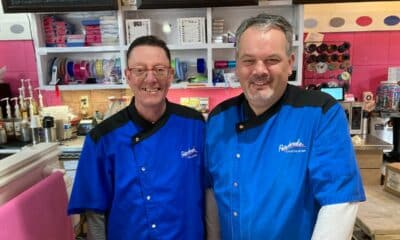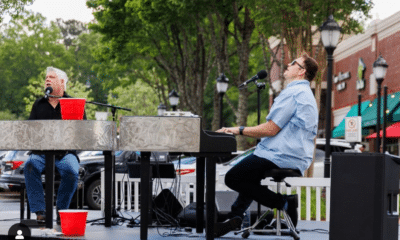Arts & Literature
Two Student Artists talk about their art and the Virtual Wesleyan Artist Market 2021
Published
3 years agoon
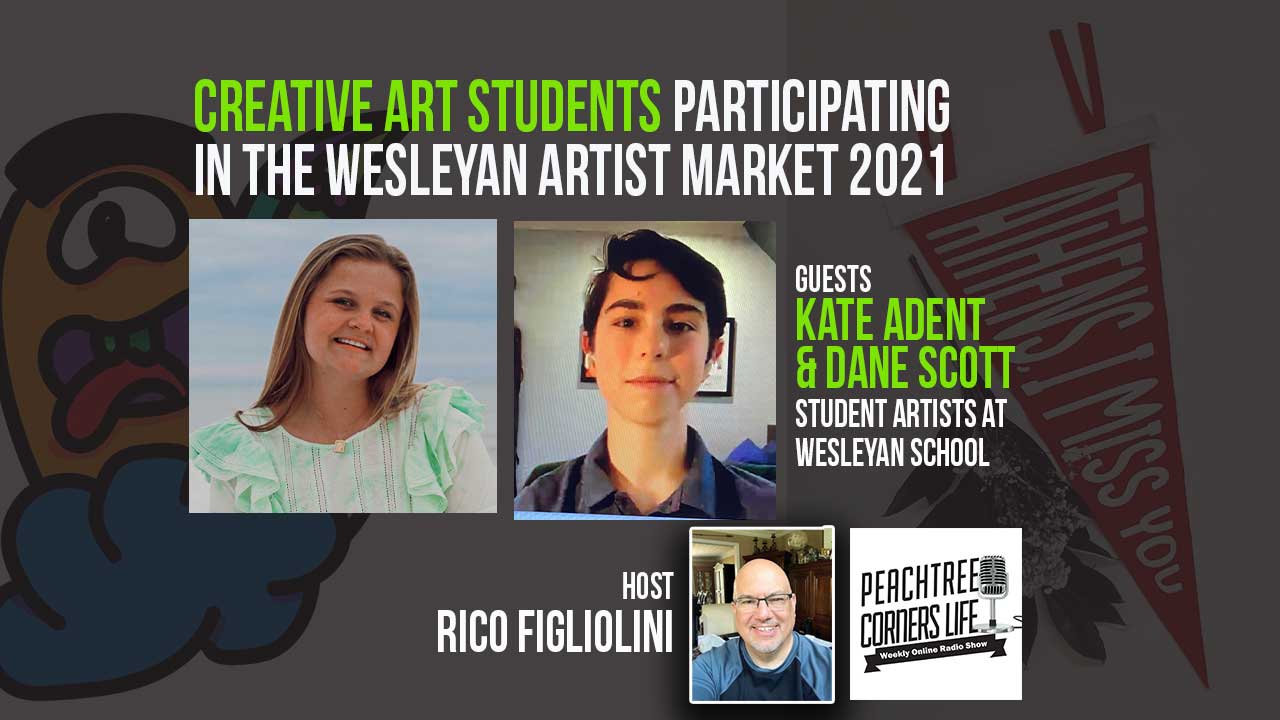
In this episode of Peachtree Corners Life, Rico Figliolini is joined by two young and inspiring student artists, Kate Adent and Dane Scott. Kate and Dane are two of many young artists that are involved in the upcoming Virtual Wesleyan Artist’s Market. Dane and Kate share their artistic journey, inspirations, and experience with the upcoming artist’s market.
Resources:
Kate’s Social Media: @KatePrints
Dane’s Social Media: @Dane_Scott19
Virtual Artist’s Market www.ArtistMarket.WesleyanSchool.org
Timestamp/Where to find it in the podcast:
[00:00:30] – Intro
[00:01:45] – About Dane
[00:04:47] – About Kate
[00:07:25] – Kate’s Art
[00:10:54] – Dane’s Art
[00:15:37] – How the Virtual Market Works
[00:17:05] – Online Versus In-Person
[00:19:05] – What’s Next for Young Artists
[00:22:47] – Experiences with the Artist’s Market
[00:24:39] – Closing
“It’s a super fun atmosphere. If there are any students from Wesleyan listening to this right now, I would encourage you to do it. At first I was kind of scared to do it… But it’s super fun and it’s fun to meet people, talk to people and just get appreciation for your work. I would encourage anybody to do it.”
Kate Adent
Podcast Trascrip
Rico: [00:00:30] Hi, this is Rico Figliolini, host of Peachtree Corners Life. And this is the show
that talks about everything about Peachtree Corners. We have special guests tonight from the
Wesleyan Artist’s Market. I’ll introduce them shortly. But in the meantime first, let me introduce
our sponsor for this show along with the family of podcasts that I do, and that’s Hargray Fiber.
They’re a Southeast regional company that provides internet connectivity to a variety of
businesses, whether you’re small or enterprise size. And they provide the tools to keep you
working, whether you’re remote or in office or you’re in a hybrid employment. With the tools that
keep you working and doing the right thing out there on the net. So check them out,
HargrayFiber.com or Hargray.com if you’d like. And thank you guys for supporting us. So we
have two special guests. One of them is a four year veteran of the Artist’s Market and the other
one’s a newbie, if you will, first year on the market. Both talented students of the Artist’s Market.
And this is what tonight’s show is about. So we’re going to be interviewing them. Let me bring
them on. And we have Kate Adent and Dane Scott. Hi guys. Thanks for showing up. I
appreciate you being with me.
Dane: [00:01:44] Thank you for having us.
Rico: [00:01:45] Sure. So you know, Kate has the work that she does is calligraphy and
photography, and we’ll get into that. And Dane Scott. Do I have the names right? Yes. Dane
Scott. Yes, cool. This is what happens during these shows. So Dane is an artist that does a
variety of things along with sticker art graphics. So what I want to do is I want to talk to and bring
them on individually for a minute to talk a little bit about who they are and what they do. So let’s
do, let’s have Dane Scott on first, and you tell us a little bit about yourself Dane.
Dane: [00:02:19] Thank you very much for having me tonight. My name is Dane Scott. I’m in
ninth grade, almost 16 years old, and I will be participating in this year’s Wesleyan Artist’s
market.
Rico: [00:02:34] So tell us also a little bit about, you know, what do you do at school, what your
activities a little bit are like. How’s Wesleyan as far as an environment like that?
Dane: [00:02:43] Wesleyan is a great and fantastic environment. I love all my friends there. We
have really deep spiritual connections and I honestly enjoy every moment there. I participate in
a couple of afterschool activities. I actually participated in marching band in the summer and fall.
And then I now participate in mock trial.
Rico: [00:03:08] Cool. That’s great. So, and tell us, just give us an idea of the type of work you
do artistically.
Dane: [00:03:15] Artistically, I love using programs such as Illustrator and sometimes a little bit
of Photoshop to just express my art. I used to use Tactile art, such as Posca Paint Pens, which
are acrylic paint pens. And I used to draw on basically everything. I would draw on my drum
heads. I would draw on phone cases. I would draw on mint tins even, for Altoids. And Iexpressed my art that way, but some other ways to express my art and I find it easier to create
art and to make new products and images using illustrator.
Rico: [00:03:56] And you were telling me a little bit before the show that one of your inspirations
came from Vexx. Tell us who that is and what inspired you.
Dane: [00:04:05] Yes, sir. Vexx as far as I understand is a Swedish artist who he does a lot of
fun, really fun cartoon work, tons of colors. And a lot of people are inspired by him. I follow him
on my social media platform. And I originally got inspired about a year ago to this date. I got
inspired by him and I wanted to you know, give a twist of my creativity to his art. So I started
drawing and practicing doodling and drawing like he did. I watched tons of his videos about how
to doodle and creative thinking process. And I managed to express my creativity that way.
Rico: [00:04:47] We’re going to be showing some of his artwork a little later in this podcast. So if
you’re listening to this, please check out our video. But let me also bring on now, Kate Adent into
the show too. Hey Kate. Thanks for waiting in the wings.
Kate: [00:05:02] Yes, thank you for having me.
Rico: [00:05:04] Sure. So tell us also a little bit about yourself to the same way that Dane was
able to talk about his experience and what he does. Tell us, I know you do softball also. So tell
us a bit about your experience.
Kate: [00:05:16] Yeah, so I’m a sophomore at Wesleyan. Like you said, I’ve done the market for
a few years now. I play softball and I used to play lacrosse, but that’s over. Oh, but yes, so like
Dane was saying I use a lot of Photoshop and Illustrator Indesign for my art. And when I do my
calligraphy, I’ve started using an iPad. So I use Procreate, which has really just made it easier
for me to get custom work out faster. So that has been super helpful for me. And I’ve also, Oh,
sorry. Were you going to say something? I’ve also been into photography a lot recently, so I use
Lightroom to edit those photos.
Rico: [00:05:53] So, right. So as far as inspiration, I mean, I know that Dane had Vexx inspire
him. Where do you find your inspiration to do some of the artwork or calligraphy that you do
even?
Kate: [00:06:05] Honestly, it’s just like influencers that I follow on Instagram. A lot of different
calligraphy accounts. That’s how I found out about Procreate. And I have a lot of friends at my
church that do stuff like I do. So I’ve been able to learn from them a lot.
Rico: [00:06:18] Interesting what you said before about doing, it sounds like commission work is
what you do also. So, and you even, so when someone, what’s a typical commission work that
someone would want from Kate Adent?Kate: [00:06:32] Well, I’ve done work for like weddings, I’ve addressed wedding invitations. A lot
of special events like signs. And my brother got married recently, so I was actually able to
design and produce all of his, like all of the paper needs. Like signage, menus, invitations,
everything for that. So just stuff like that.
Rico: [00:06:55] And when you do, so people actually, you’ve actually set up a website of your
own. Not only can you, can anyone here find your work at Wesleyan Artist Markets soon to be
opened virtual artist’s market, but they can also come to your website, right? And what’s that
website address?
Kate: [00:07:15] KatePrints.com.
Rico: [00:07:17] Cool. So, and if they wanted to buy specific custom commission work, they can
do that through that site with you?
Kate: [00:07:24] Yes, sir.
Rico: [00:07:25] Excellent. So let’s do a little bit of show and tell here and we’ll start. We’ll start
with you Kate first. So I’m going to bring on some pieces that you’ve done. So bear with me a
second. So some of the work that you sent me. So tell us, so obviously calligraphy is part of the
market, right? Is being sold at the market, I guess?
Kate: [00:07:48] Yes, sir.
Rico: [00:07:49] Excellent. So you want to tell me a little bit about this one?
Kate: [00:07:54] Yes. So this was just a piece of commission work I did for a friend just for her to
give as a gift. Just a Bible verse for one of her friends.
Rico: [00:08:03] Okay. And you have another one there let’s do this one.
Kate: [00:08:06] Yeah, so I think there was a couple of those just examples.
Rico: [00:08:10] Right. So there’s another one there that you did that was also commission work
I’m assuming.
Kate: [00:08:17] Yes, sir.
Rico: [00:08:18] Right. And actually you even have almost like a font library.
Kate: [00:08:25] Yes. So all of that was handwritten. Like I said, I do that in Procreate. So that’s
actually a print that I have for sale on my website.Rico: [00:08:32] And you’re also putting, so if someone wanted to buy, let’s say a pen. Let me
get this one up. I’ll show you. Like that one. That’s one of yours too, I think right?
Kate: [00:08:43] Yes.
Rico: [00:08:44] So tell us a little bit about that and what you’re, what you’re doing with this.
Kate: [00:08:48] Yes. So like about this time, last year I started my website and for the most
part, it was just like paper prints and stuff like that. So I wanted to add something else. And so,
like I said, a person I follow on Instagram had started to make these flags. So I designed like the
writing on my computer and then I print them out on my silhouette machine and he pressed
them and they’re yes. And they’re all hand-sewn.
Rico: [00:09:18] So you have a silhouette machine? That’s cool.
Kate: [00:09:21] Yes.
Rico: [00:09:23] So you’re a maker in Peachtree Corners.
Kate: [00:09:26] I am. Yes, sir.
Rico: [00:09:28] And so the flower on that decorative portion of it, does that also come with the
banner or is that just part of the photography?
Kate: [00:09:35] That was just part of the picture.
Rico: [00:09:37] Okay. But anyone can commission these types of banners with you, I’m
assuming?
Kate: [00:09:41] Yes, sir. I’ve made a bunch of customs for people, for different events, and for
gifts.
Rico: [00:09:46] Okay, cool. And of course we were talking before about photography as well.
And you’ve done some photography work it seems also. Are you is that also again, I mean, is
that commissionable too? If you do photography?
Kate: [00:10:04] Yes, it is. I’ve been doing some senior pictures recently. That’s that. Yes, sir.
That’s one of my friends from school. And then I’ve also been asked by the varsity baseball
coach at Wesleyan to be the team photographer this year. So that’s been super fun getting to do
other stuff and to learn other things.
Rico: [00:10:25] Well, it’s good to see the work that you’re doing. And you know, you’re young.
Although this is your fourth year, has it changed from what you did the first year to what you’re
doing in the fourth year?Kate: [00:10:36] Yes sir. So the first year I actually did the market with a friend and we did
monograms. This was in sixth grade. So with my silhouette, like cutting machine, I made
monograms and stickers for, and I sold those. But now I’m just doing more calligraphy type work
Rico: [00:10:54] Alright. Now let’s bring on Dane. Dane? I want to be able to show some of your
artwork also. And maybe you can give us a little explanation of some of the artwork that I’m
going to be putting up here.
Dane: [00:11:07] Awesome.
Rico: [00:11:09] So give us some background on some of these pieces.
Dane: [00:11:14] So this is my, actually, this is my most recent piece that I’ve done. And I always
start my process by outlining everything. So I take a black marker and Adobe illustrator and I do
all the lining for it. And then the next step, I create like the facial expression. So I create the
lining of the character and that little orange guy, right there will be totally blank. And I will come
up with what I want the scene to be. So say I wanted him to be sad. You know, I might’ve added
a frowny face and the eyebrow to be lowered and the cloud might be gray and crying or
something like that. But in this case I needed it to be a happy picture. Like most of my works. So
I proceeded in that way and it turned out as this.
Rico: [00:12:09] Cool. Now, not a happy guy.
Dane: [00:12:11] No, I have two of those styles. I actually have one with me right here. I have
another one that I did in the similar style is that it’s a storm cloud with big, angry, eyebrows and
a lightning coming out of it. But anyway, in that cactus picture, in that cactus picture I was kind
of, I wanted some inspiration. So I told my family to, you know, think of a random object and my
sister shouted out cactus. So I was like, Oh, that’d be fun. So I drew that one afternoon after I
did my homework. And it turned out like that.
Rico: [00:12:52] And the strawberry that I’m bringing on, now.
Dane: [00:12:55] The strawberry. So originally before I started doing stickers, a big thing of mine
was doing sliced up fruit. Like not, like I drew sliced up fruit and I thought it would be really cool
to translate some of my original works into stickers. So I think I have maybe five fruits in my little
sticker stockpile right here.
Rico: [00:13:19] So you said you earlier, I think while we were up, this was pretty sure you said
you used Sticker Mule to be able to do this?
Dane: [00:13:27] Yes, sir. I send it over to the people at Sticker Mule and they are really quick to
respond. Most of my stickers, I can get ordered within the first, you know, eight hours. They
approve it. They go through and do all your edits for you. It’s fantastic.Rico: [00:13:44] Wow. And how long, what’s like your normal order of stickers when you do
that?
Dane: [00:13:49] I usually purchase the stickers 10 at a time for about $9. So it’s a really good
price. You can look all over the web and other websites. You know, they’ll have it a little bit
higher or a little bit lower, but these are really good quality. They’re waterproof, heat resistant.
They’re 3M which means they’re like super sticky and they’re, you know, what a kayak sticker
is? A kayak sticker so basically, you know, it, you can kayak in it. So it’s super durable. It’s really
heavy grade and it doesn’t scratch easily or wear easily. And I’ve actually had some on the back
of my phone case right now for about six months. And they do not fall off or scratch or wear
anything. They are super durable and high quality.
Rico: [00:14:40] You know, it’s funny because one of the companies I do work with, it’s a media
company and they’ve been sending out stickers that they’ve made. I don’t know where they’re
getting them from, but apparently laptop stickers is the big thing, right? What about this one?
Dane: [00:14:54] This is a pizza. This was actually the third design I ever made. I think the
strawberry was the first. No, the strawberry was the second. This was the third design because I
just like pizza and I thought that was a really fun, colorful design.
Rico: [00:15:09] And this is the last one right, in the series?
Dane: [00:15:12] Yes, sir. So this was originally when I hit 100 followers on Instagram. I actually
put this flaming pickle in the piece and my dad’s like, Oh, that’s a cool character. You should
include that on the stickers on like, yeah, I should. So I drew him in Adobe illustrator, sent him
off to sticker mule, and I got him about seven days later, so.
Rico: [00:15:37] So I’m going to bring us all three on at this point. And just want to be able to go
a little further and just talk a little bit more about the Wesleyan Artist’s Market. So, you know,
how is that working as far as you being able to put your art on and you know, what’s the
process? So if someone wants to buy your work, how would that work out? Who wants to go
first?
Kate: [00:16:00] I can go. So as far as I understand, or as I know it’s a website that’s going to go
live day of market and anybody is just able to go on and shop through the different sites of
different vendors that are all students. And then there’s going to be another section of like the
professional artists that would normally be in market. And you’re just able to shop through there.
Rico: [00:16:24] So now, if anyone has questions about your artwork or if they’d want
commission work? Because, you know, they like the sticker that you do, or they like the
calligraphy that you’re doing, or the banners would they be able to reach you through that artist’s
market as well? I imagine.Dane: [00:16:41] As far as I understand, we, the student artists are not allowed to have our
personal phone numbers. We are allowed to have our social media accounts however, and not
a parent email. I think they will allow people to leave their comments and then forward those
emails to us, where we may respond. Just to add a little bit more security to the student
operation of it.
Rico: [00:17:05] Sure, sure. And then, you know, doing a virtual market is lot different right, than
in-person. So obviously Dane doesn’t know the in-person side of it, but Kate would. So how was
the, you know, the interesting part? Were you at the show also showing your work when like last
year? Not last year, year before.
Kate: [00:17:25] Yes. So, it’s super fun in person. You get to be there for like three days and you
have a booth that you set up with all your work. And since we’re students we have to go to
school during the day. So a parent would like man the booth and like make sales for you, but
then right after school ends, you get to come for like the rest of, I think it’s a Friday. And then all
day Saturday, the market’s open. So you just get to talk to people and it’s super fun.
Dane: [00:17:52] So could I comment on that real quick?
Rico: [00:17:54] Yeah, sure.
Dane: [00:17:55] Well, my sister did the artist’s market last year. I showed up almost every day.
It was super fun to come after school, do my homework. The atmosphere is great. And there’s
so many talented artists there as well. So it’s really, really fun to show up and I’m sad we have to
do it virtually this year.
Rico: [00:18:11] Yeah. I mean, did you get a chance to walk around and see all the artists and
what they do? Yeah, that must’ve been fun too. Did you get a chance to even speak to some of
the artists? Cause I’d imagine, you know, artists to artists, you might have comments or
questions.
Dane: [00:18:25] Oh, sorry. Go ahead. You go ahead.
Kate: [00:18:29] I got to meet a couple of like the professional artists. They’re like on the main
floor of the gym during the market. And there’s a couple of them that I’ve gotten to meet and I’m
still really in contact with. And they’ve been a pretty big inspiration, honestly, for me too.
Rico: [00:18:45] Dane. You were going to comment as well?
Dane: [00:18:47] Yes sir. My dad actually bought a wonderful piece of the American flag and I’m
pretty sure he’s still in contact with the artist. They’ve got so many talented artists. Every one of
them is so kind and it’s really fun to talk to them about their process and how they do what they
do.Rico: [00:19:05] What do you, you know, I mean, obviously you’re in ninth grade, young artists.
What do you want to do? I mean, where do you want to start your path in life? What do you
think is your thing?
Dane: [00:19:18] That is a good question, sir. I am not fully confident in my path in life. I don’t
know if I’ll, I kind of doubt that I’ll go into a full artist career. I do like doing art as a hobby though.
I have many hobbies. I do some prop design. I do some videoing, you know. I do a little bit of
instruments and stuff. So I don’t know if I’ll pursue it professionally, but that’s a very good
question.
Rico: [00:19:47] Well you have obviously a creative vent and you, all the things that you
mentioned are in the creative realm. So maybe that road is kind of broad, but maybe that’s the
path that you might be good at. Sure.
Kate: [00:20:04] I really would love to be a graphic designer. I think that would be so much fun.
That’s been a dream of mine for a long time. I don’t know whether that would be like freelance or
if I would work with a company. But really anything would be awesome. But I’d also love to have
photography as like a part of my business or a part of my job. So that would be super cool. Like
sports photography I think is so much fun.
Rico: [00:20:25] Oh yeah, I would think. Especially if you love sports, it sounded like you started
with lacrosse and then you went to softball. So that’s definitely sports photography. Like food
photography and portrait photography are very different from each other and it does take a
talent to do those things. And you’ve really got to love it to be able to capture I think the right
moments. And have a camera that can shoot a hundred shots before you get that one, one
really good sports shot. Right? So what so now that you know, pretty much where, you know,
what do you think you’d want to do next? As far as artwork goes, Kate? I know, you know,
calligraphy, photography, what would be next years? I know we haven’t even started this year’s
yet, but what do you think would be your next project?
Kate: [00:21:16] Probably really the same stuff. I really enjoy what I’m doing and I don’t really
think I would make any other changes. If anything, I would add other pieces or other elements.
But I think I’m going to stick with calligraphy and photography.
Rico: [00:21:30] Cool. Dane what about you?
Dane: [00:21:33] I may add sort of a mixed bag if you will. I’ve been working on my computer.
I’m working on some prints right now, combining some of my characters into a scene.
Unfortunately, I can’t sell the props I actually make because that’s not legal because I don’t own
the rights to them. But I think I’ll continue with the stickers, prints, and maybe a couple of my
photos. I also like to do photography in both video games and in real life.
Rico: [00:22:04] Yeah. Actually I did notice that on your Instagram, you do video game
photography?Dane: [00:22:09] Yes, sir. I mainly focus on a game called Forza Horizon 4. I love cars racing. I
have, you know, in the basement I’ve kind of set up a little steering wheel thing with the pedals
and all that. I love racing. So I just take the opportunities to capture those cool moments when
you know, you’re swinging around the curve at a hundred miles an hour in your car, and you can
just capture that moment. So it’s really fun to do that.
Rico: [00:22:36] You’d almost want to do that in a VR setting.
Dane: [00:22:40] Yes, sir. My cousin actually put me in his VR thing and it’s a little bit nauseous
going that fast.
Rico: [00:22:47] The Oculus quest for my son. And I had to set up an area for him so then he
wouldn’t bump into the walls. Cause when you’re moving around in that you have no idea where
you are. And I had actually set up a tactile area for him so that if he steps off it, he knows he’s
going into a wall or something. So, yeah. And that can be a little, I tried it on and it just. I’d like to
be in there for a little longer, but he took it back. He was like Dad, no it’s mine. Cool. So we, do
you guys want to, Kate, do you want to share anything else about your experience with your
artist’s market that you know, maybe you’d like to share with people?
Kate: [00:23:22] Gosh, I don’t know. Just that it’s a super fun atmosphere. And like, if there is
any students from Wesleyan listening to this right now, or when it comes out, I guess. That I
would encourage you to do it. Cause at first I was kind of scared to do it because I only saw like
high schoolers doing it and I did it in middle school. But it’s super fun and it’s fun to meet people,
talk to people and just like get appreciation for your work. I would encourage anybody to do it.
Rico: [00:23:47] That’s cool. And I especially appreciate being a business person. The fact that
you set up a website to sell your own stuff as an entrepreneur, that’s a great thing to do and a
great experience I think.
Kate: [00:24:01] Yes, it was super fun too.
Rico: [00:24:04] Right. And still more to come I’m sure.
Kate: [00:24:07] Yes. I’ve learned a lot from that for sure.
Rico: [00:24:10] Dane what about you?
Dane: [00:24:11] Actually on the point of the website, one aspect of this artist market that I’ve
enjoyed. We as artists actually get to set up our own little web page that we can kind of show
what we’re about. We get a description, you know, we get to have our banner or colors
everywhere to show, you know what we’re about as an artist. And I think that’s another aspect
that they previously didn’t have in the artist market. And that adds to it in a way.Rico: [00:24:39] After speaking to Gina Solomon and some of the other women that guide the
Wesleyan artist market, I think this is definitely, even though they were forced to do a virtual
artist’s market because of the pandemic. This is something that they realize they do want to
keep. And it does expand that exposure for the artists. Not only, you know, student artists, but
certainly the professional artists. So it’s a great place for people that cannot come to the artist
market to be able to see what’s going on. So that’s kinda neat that way. So we’ve been talking to
Kate Adent and Dane Scott, students at the artist’s market, Wesleyan artist market that opens
April 20?
Dane: [00:25:19] April 22nd through 29th. It’s a week of shopping. Early shopping is available
for those who sponsor the event and it is www.ArtistsMarket.WesleyanSchool.org.
Rico: [00:25:34] You’d be a great cohost. Good job, thanks for helping out. We’ve been talking
to some great artists here and I think that whatever they do in the future, it will be exciting for
them. So, and listen, if you want to follow them, actually, where can they, Kate, where can they
follow you on?
Kate: [00:25:51] I have an Instagram and a Facebook and both of them are just @KatePrints.
Rico: [00:25:56] Okay. And Dane?
Dane: [00:25:58] Yes. If you want to see more of my work, I’d be happy to show you. It’s
@Dane_Scott19.
Rico: [00:26:08] Excellent. Alright, I appreciate your time. Appreciate you being with me. Hope
everyone enjoyed this and looking at the artwork of these kids. But definitely check out the
Wesleyan Artist’s Market in the student section, because there are other students as well there
too. And the professional artists that have been curated and juried for this. So check that out. It’ll
be a good show. Thank you for being with us.
Dane: [00:26:31] Thank you very much
Related
Arts & Literature
8 Theatrical Performances Coming to the Peachtree Corners Area
Published
2 weeks agoon
April 10, 2024By
Kathy Dean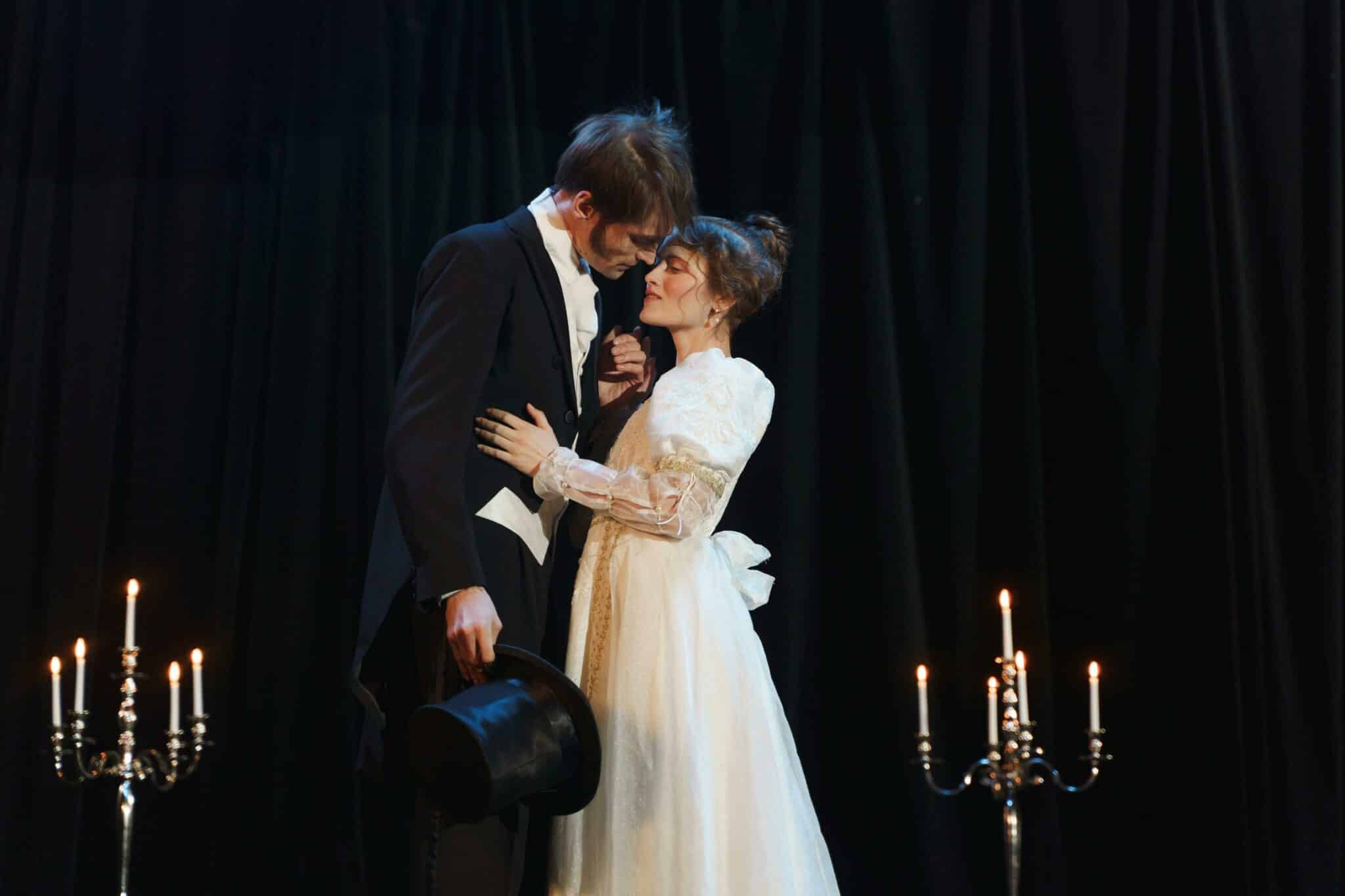
Mean Girls: High School Version
Thursday-Friday, April 11-12
Thursday and Friday, 6 p.m.; Saturday, 2 p.m.
Paul Duke STEM High School
5850 Peachtree Industrial Blvd., Norcross
Tickets: Adults, $12; students, $10 and children (ages 5 and under), $5
Adapted from Tina Fey’s hit 2004 film, the Mean Girls musical has been nominated for a staggering 12 Tony Awards. Now, Paul Duke STEM brings the high school version of the show to life.
Tickets are on sale and can be purchased here.
The Curse of the Hopeless Diamond
Thursday, April 18. 6:30 p.m.
Anna Balkan Jewelry and Gifts
51 S. Peachtree St., Norcross
Ticket: $25, includes snacks and one glass of wine
The audience-participation murder mystery is a fundraiser for Lionheart Theatre’s summer theatre camp for kids and teens; it’s being hosted by Anna Balkan and 45 South Coffee House.
About the show: Reginald and Daphne Potter are touring extensively, along with their world-famous Potter Diamond, in the company of four detectives. It’s well-known that the Potter Diamond is beautiful…and cursed!
Purchase tickets here.
Anastasia
Thursday-Sunday, April 25-28
Thursday and Friday, 7 p.m.; Saturday, 2 and 7 p.m.; Sunday, 3 p.m.
Valor Christian Academy
4755 Kimball Bridge Rd., Alpharetta
Tickets: $20 per person
About the show: Presented by CYT Atlanta, the show spans from the twilight of the Russian Empire to the euphoria of Paris in the 1920s as a brave young woman sets out to discover the mystery of her past. Pursued by a ruthless Soviet officer determined to silence her, Anya enlists the aid of a dashing con man and a lovable ex-aristocrat. Together they embark on an epic adventure to help her find home, love and family.
Click here to learn more.
Little Shop of Horrors
Thursday-Sunday, April 25-28
Thursday, Friday, Saturday, 7 p.m.; Sunday, 2 p.m.
Norcross High School
5300 Spalding Dr., Norcross
norcrosshigh.org, nhs-drama.com, 770-448-3674
Tickets: $10
About the show: A horror comedy rock musical, Little Shop of Horrors centers around a florist shop worker who raises a carnivorous plant that eats humans.
Secure your spot.
Seussical
Thursday-Saturday, May 2-4
Wesleyan School Powell Theatre
5405 Spalding Dr., Peachtree Corners
wesleyanschool.org, 770-448-7640
About the show: The fantastical, magical musical is based on the children’s stories of Dr. Seuss.
Discover more here.
Breaking Legs
May 3-19
Fridays and Saturdays, 7:30 p.m.; Saturday, May 18 and Sunday matinees, 2 p.m.
Lionheart Theatre Company
10 College St., Norcross
lionhearttheatre.org, 678-938-8518
Tickets: Adults, $18; students and seniors, $16
About the show: In this madcap comedy, an Italian restaurant is owned by a successful mobster and managed by his beautiful unmarried daughter. When the daughter’s former college professor asks for financial backing for a play he’s written about a murder, the three main Mafiosi are intrigued with the idea of producing a play. The daughter becomes enamored of the playwright who discovers, through the ‘accidental’ death of a lesser thug, that his backers are gangsters.
Find tickets here.
Finding Nemo JR
Friday-Sunday, May 10-12
Greater Atlanta Christian School King’s Gate Theatre
1575 Indian Trail Rd., Norcross
greateratlantachristian.org, 770-243-2000
About the show: The hour-long musical adaptation of the Pixar film features Marlin, a nervous clownfish who lives with his adventurous child, Nemo, in the Great Barrier Reef. When Nemo is carried off to Sydney, Marlin must overcome his fears and travel across the ocean to find him.
Learn more here.
Much Ado About Nothing
Saturday-Sunday, May 11-12
Saturday, 2 and 5 p.m.; Sunday, 3 p.m.
Simpsonwood Park
411 Jones Bridge Circle, Peachtree Corners
crewofpatches.org
About the show: Contemporary Classics Theatre presents Shakespeare’s romantic comedy May 11-26 at Simpsonwood Park in Peachtree Corners, Christ Church Episcopal in Norcross and Autrey Mill Nature Preserve in John’s Creek. Director Susanna Wilson’s version of the play is set in Italy during a 21st century film festival. Love at first sight, jealousy and confusion, an illegitimate sibling, mixed-up lovers, three weddings and a funeral fill this amusing look at love, betrayal and acceptance. Performances will be outside for a “Shakespeare in the Park” experience. Audience members should bring blankets and lawn chairs as no seating is provided. Shows run approximately 100 minutes with no intermission.
Click here for more information.
Want more event happening in and around Peachtree Corners?
Check out our recent article: 25+ Free Events Happening at Peachtree Corners Library in April and May
Related
Arts & Literature
Wesleyan Artist Market 2024: Spotlight on Three Artists
Published
3 weeks agoon
April 2, 2024
Singing birds, blossoming flowers and warmer days — the delights of spring herald the 26th annual Wesleyan Artist Market (WAM) in Peachtree Corners, a vibrant celebration of art.
Discerning art enthusiasts head to Wesleyan School, located just north of Atlanta, for a chance to explore paintings, photography, mixed media, ceramics, jewelry and beyond from over 80 professional artists.
Mark your calendars: this year’s market takes place Friday, April 26, 10 a.m. to 7 p.m., and Saturday, April 27, 10 a.m. to 3 p.m. Stop in and immerse yourself in creativity!
Ashley Skandalakis
Returning to WAM for the second time is an artist who combines colors and textures not on canvas, but in an array of unique and lovely flowering vessels. Ashley Skandalakis, owner of Atlanta Planters, LLC, creates custom designs of planted pots to adorn your home or business and can fit all styles and budgets.

Before this southern belle raised in Americus, Ga. started playing in the dirt, she tried several different careers — from interior design to pharmaceuticals, technology to entrepreneurship. Skandalakis took a sprout of an idea and turned it into a blooming, multi-million-dollar business with her Lappers dining trays. Now she’s well on her way to growing Atlanta Planters.
For the past five years, Skandalakis has been making metro Atlanta more beautiful one potted planting at a time. She attributes the company’s growth to her unique style, attention to detail, outstanding customer service and beautiful products.
Start before you’re ready
After quitting her stint in the technology field, Skandalakis was in search of the next sensation that would produce the same rush her tray invention and eight patents gave her. A friend opened a new Buckhead restaurant and Skandalakis offered to replant her waning orchids. The restauranteur, lacking time and funds, agreed.
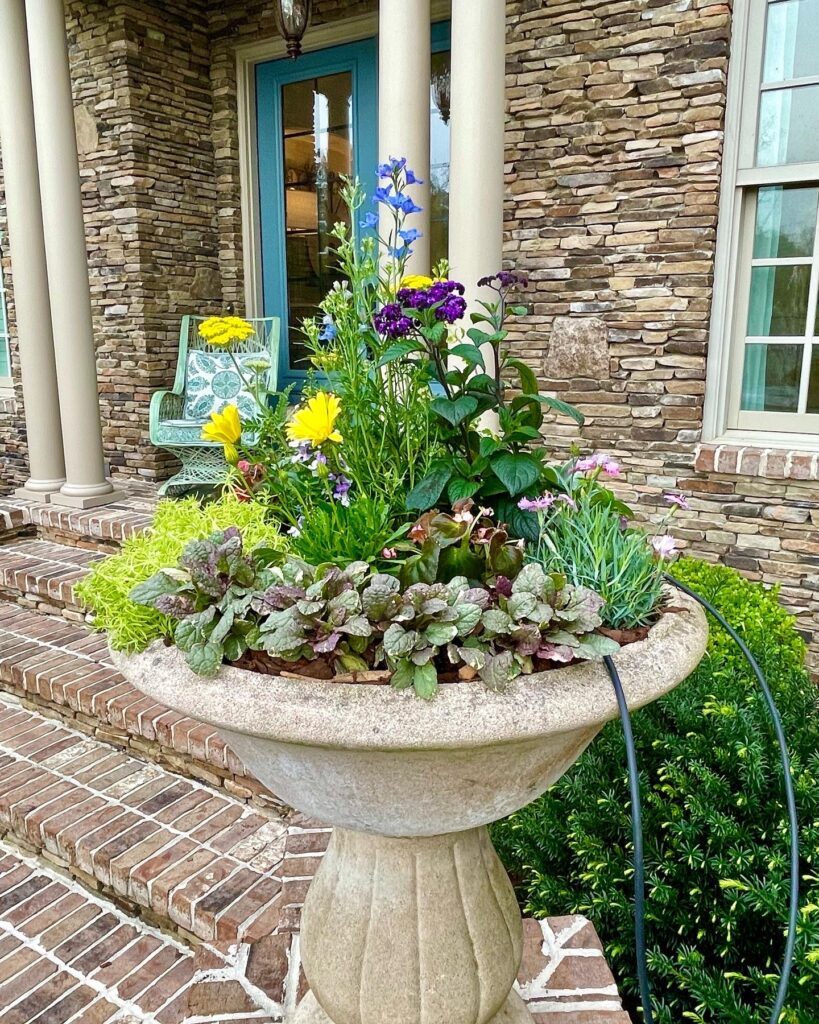
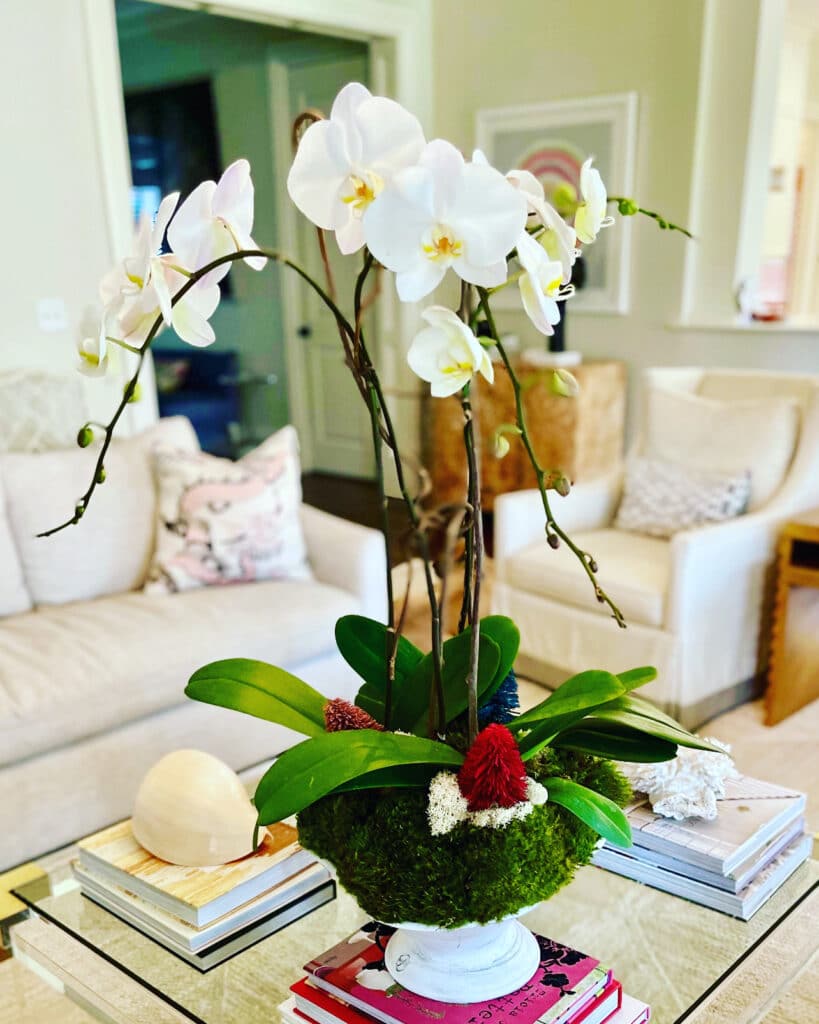
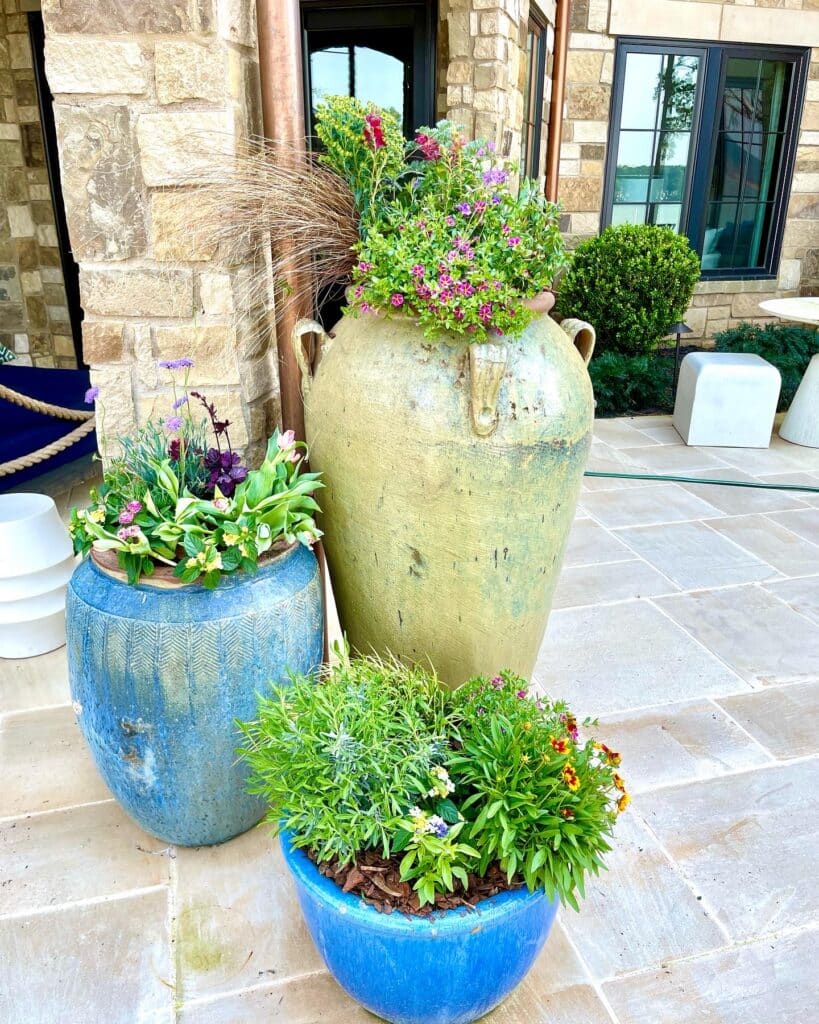
Self-taught Skandalakis took the vessels home, gathered orchids and supplies, and created striking compositions embellished with interesting stakes, moss and other plants. Dining patrons were so impressed by her eye-catching creations that they requested her business card as she carried them through the restaurant during delivery.
“When you’re passionate about something, you figure it out as you go,” she said. “Every day you wonder, ‘What am I going to learn today?’”
Rental truck road trip
At the suggestion of a painting class comrade, Skandalakis submitted photos of her fanciful florals to the Thomasville Antique Show. Two days later she committed to being a vendor in a show taking place in a week’s time.
“I had to source planters, orchids. I didn’t have a business license. I didn’t have business cards. I didn’t have a credit card processor. I didn’t have anything, but I pulled it all together. I stayed up till 1 o’clock in the morning making 45 orchid compositions. I really didn’t know how to do them, so it took me a long time,” Skandalakis shared.
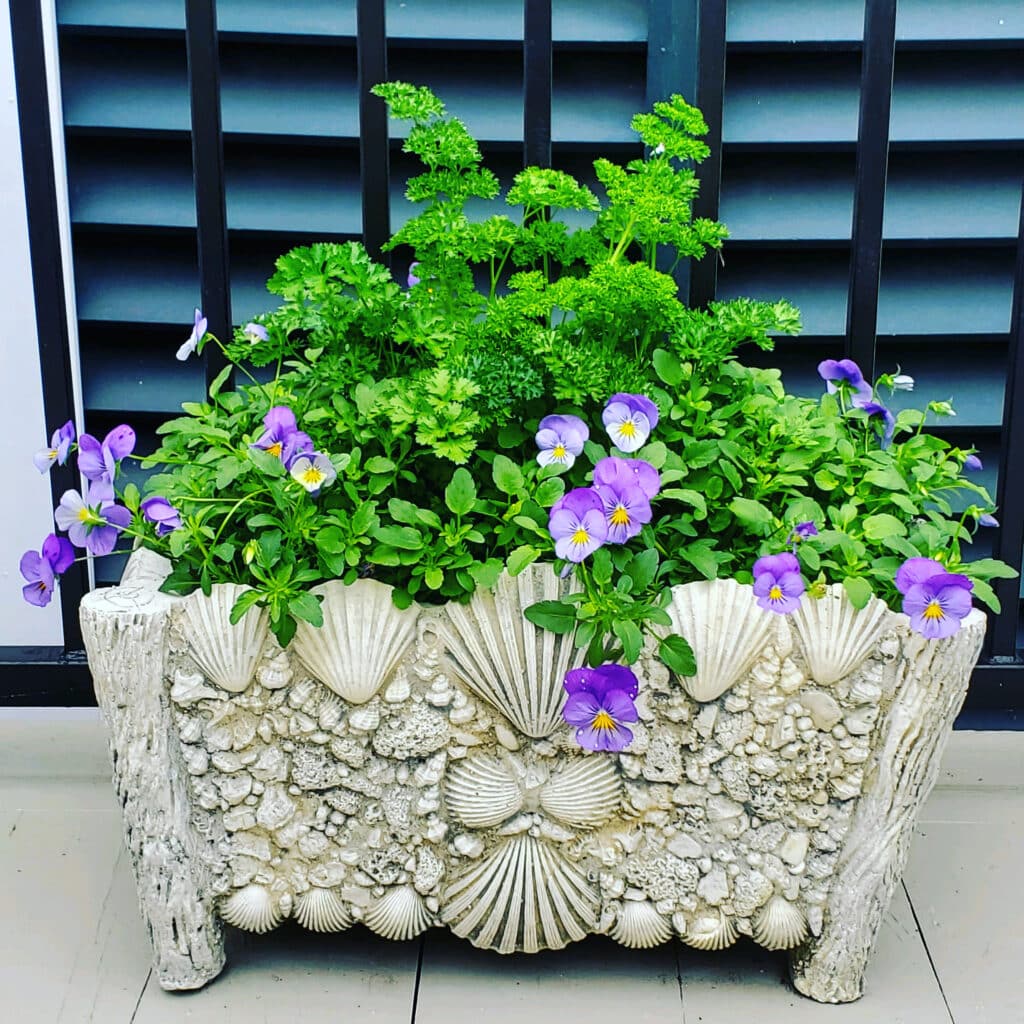
Turning a $5,000 profit at that show in February of 2020 made her realize she had a new business. When the pandemic shut everything down in March, Skandalakis pivoted to outdoor containers and embraced her budding bailiwick with verve.
Busy beautifying outdoor spaces
Applying for a business license, building a social media presence and advertising led to some scheduled appointments. By May of that year, Skandalakis was fully booked creating seasonal planters for clients.
“Twice a year, I go to clients’ homes and make their planters gorgeous. If they need planters, I source those too. I love working with people to find the best containers for their space,” Skandalakis beamed.
It’s a carefully orchestrated juggling act to get everyone’s plantings done. The season begins on April 15, when frost no longer poses a threat, and runs through the end of June. Winter pots are cleaned out and planted for the spring and summer. In October, the remnants of summer plantings are removed, and containers are replanted for fall and winter.
During the Christmas season, Atlanta Planters decorates fireplace mantles and front porches with handtied greenery, garland, lights and wreaths.
Perfect planters and plants
The quest for unusual urns from across the globe excites the impresario who works with vendors to source the best, whether modern or traditional. Preferred supplier Elegant Earth makes handmade products in Birmingham, Ala. The owner is an Atlanta native who is featured in Veranda magazine this May.
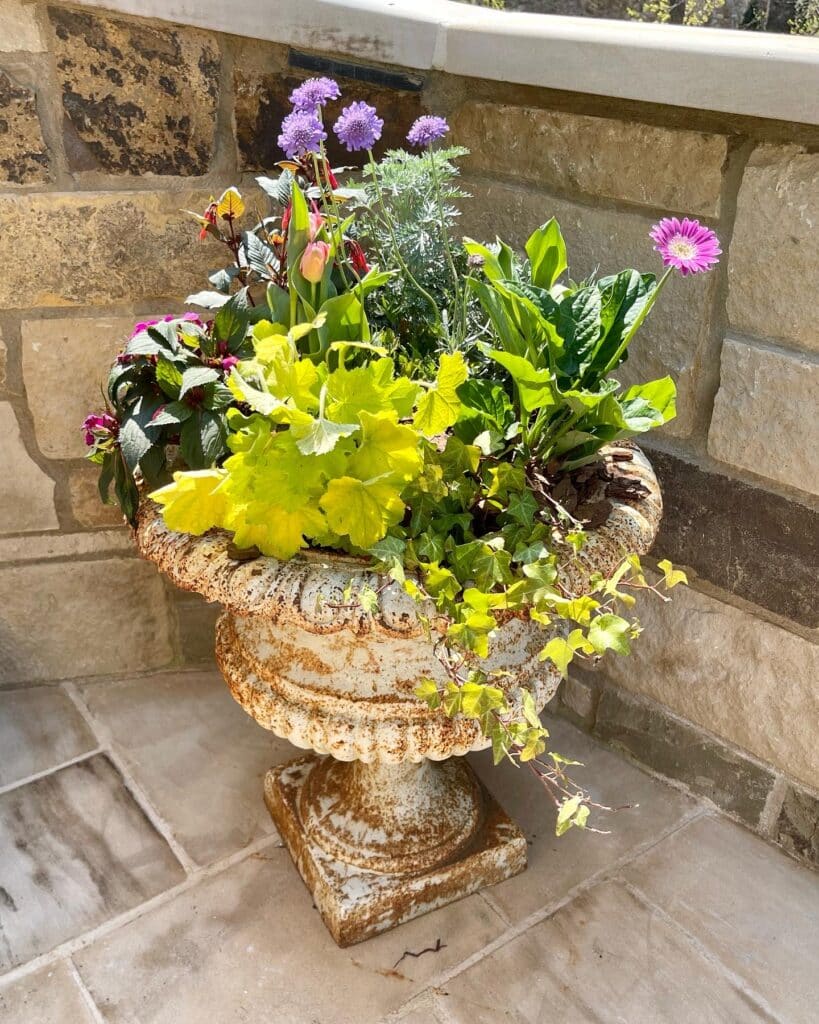
Skandalakis searches online auctions for vintage and antique vessels. She also scours the trade market in High Point, N.C. When associates have shipping containers arriving from abroad, they often give Skandalakis first dibs at their treasures.
Annual trips to Europe further the flowerpot obsession. Her travels usually entail securing planters while endeavoring to piggyback on friends’ cargo containers to get them across the pond.
Several hundred planters can be found at her Marietta store on any given day. Skandalakis intentionally purchased a deep lot to house them all.
A variety of wholesale nurseries around the southeast supply Skandalakis with the highest quality plants. Annuals and perennials usually come from local nurseries. Larger landscaping plants come from all over the region where the heartiest plants intersect with competitive prices.
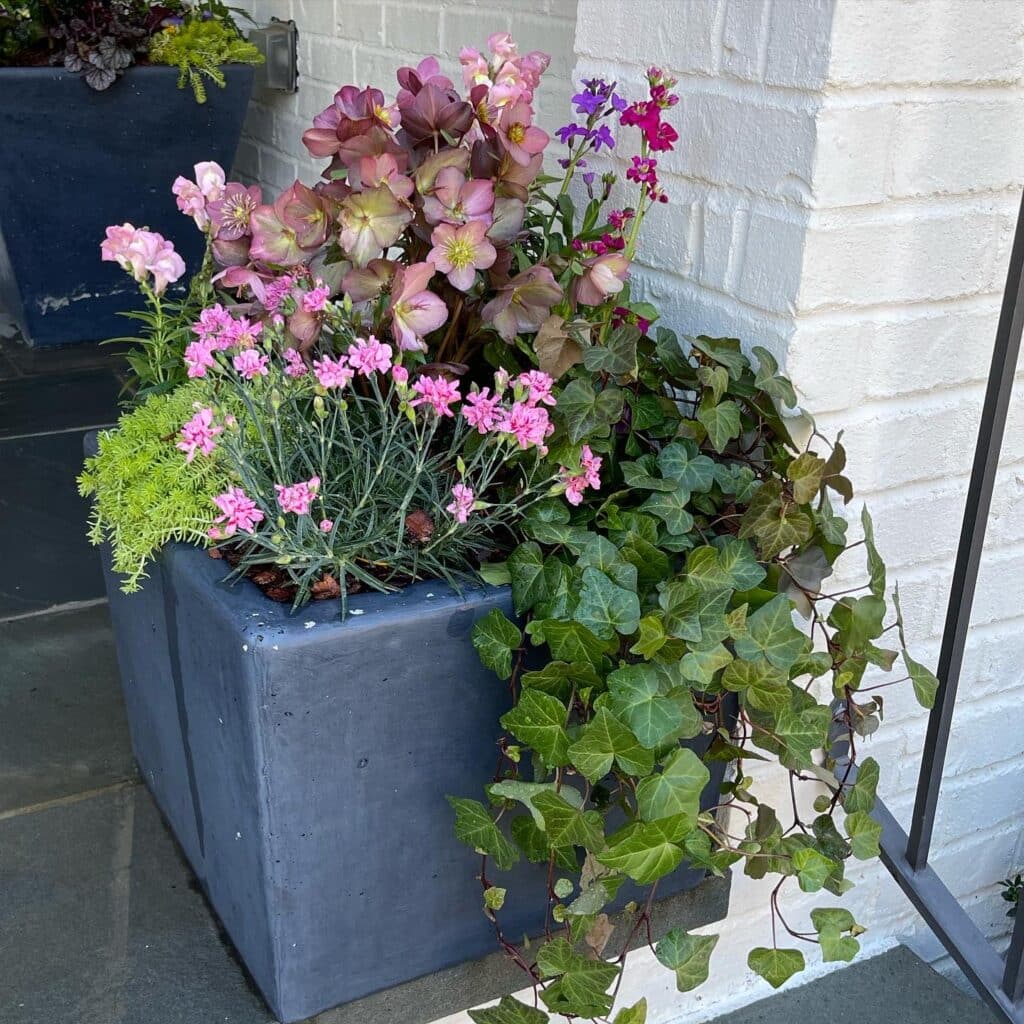
Continuous growth
Though planters make up the majority of her business, those entrusting Skandalakis with their pots naturally began to ask her for landscaping advice as well. To better assist clients with landscape design, Skandalakis sharpened her skills at Emory University.
“I enjoy landscaping projects. Inspired by some of the world’s best landscape architects, I am constantly learning. It’s important to continue to grow,” she asserted.
A $600 minimum per planting session covers plants, healthy soil, fertilizer, plant toppers and labor. Skandalakis’ green thumb leaves clients happy with their containers.
Clients old and new
Customers who’ve been with Atlanta Planters for a while trust the gardener’s judgment. They’re happy to allow her artistic liberty. Skandalakis knows her clients’ favorite colors and which locations require shade or sun plants.
New clients are asked to provide pictures of their home, yard and planters. She believes the outside of the home should be an extension of the inside in terms of style — whether it’s modern, traditional or transitional.
Next, Skandalakis inquires about her clients’ sun/shade situation, access to irrigation, whether they have pets and if deer are an issue.

Floral designs to suit your lifestyle
Are you a good plant parent? Skandalakis can plant superb succulents for those who may habitually “forget” to water their containers. A building’s architecture and the client’s taste also can dictate what types of plants and containers are used.
Boxwoods in planters that tell a story look best on traditional properties. Grasses in sleek metal or concrete white pots are typical of modern estates.
Bright and happy
Every day brings joy; clients are happy to see her arrive and enamored with their containers when she leaves. Skandalakis once daydreamed about people who loved their job; now she professes to be one of them.
“When you enjoy what you do, it’s not a job at all,” she smiled.
The same look of satisfaction spreads across her face when she speaks about having shown her children that we’re capable of anything we put our minds to, without limitations.
WAM
Last year Skandalakis was blown away by the phenomenal show where she made new acquaintances and gained clients. Her large planters adorned the Wesleyan campus outside as well as the gym. The show takes place during her busy planting season, so Skandalakis and her team worked on weekends to prepare.
Expect to find a variety of planter sizes and types in her booth — some planted — in addition to orchids, other plants, indoor compositions and appealing merchandise from her shop. Last year she brought cowhide chairs from a Texas auction.
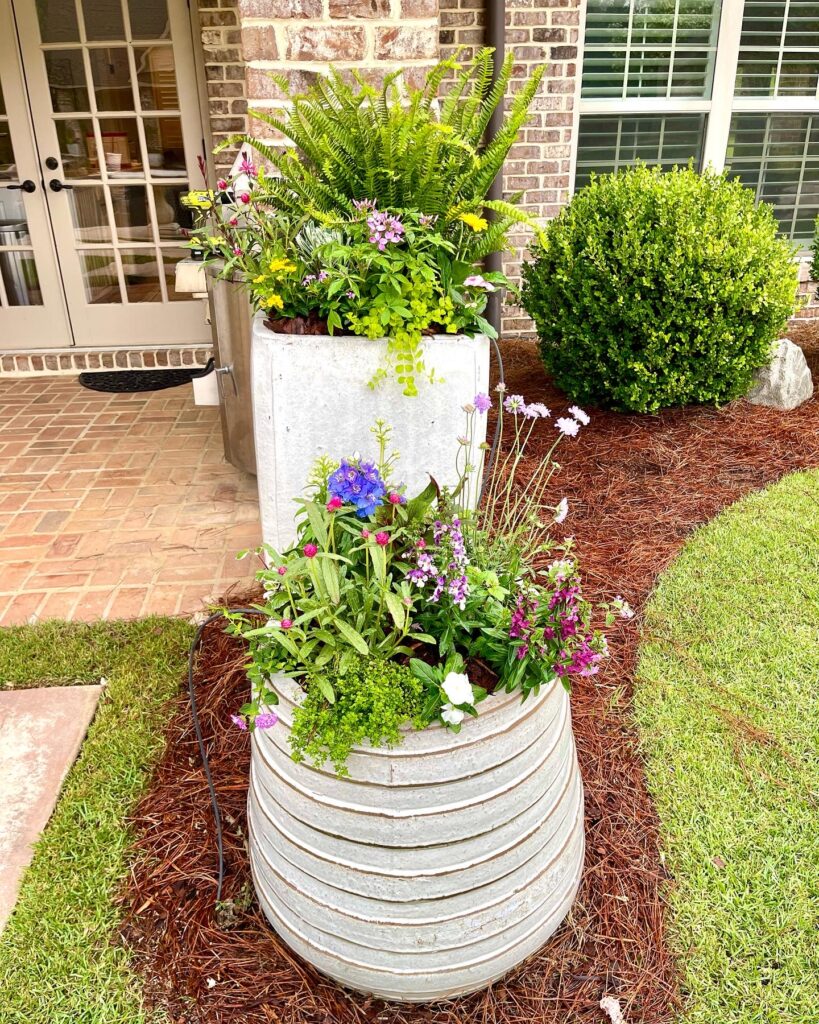

Book Atlanta Planters
An enterprising lady behind two successful businesses, Skandalakis enjoys sharing her inspirational story with women’s groups.
Listen to her friendly Southern drawl as she introduces loads of products and her latest “Five Favorite Things” on Instagram @atlantaplanters.
To learn more about Atlanta Planters or to obtain a quote, visit atlantaplanters.net or call 706-289-5736.
Stop by the Marietta flower shop for swoon-worthy, seasonal merchandise at 324 N. Fairground St. and find beautiful indoor plant compositions, orchids, gifts and an eclectic selection of indoor and outdoor planters. Skandalakis and her team can “plant them up” for you on site.
Elaine Jackson
In the quaint setting of Madison, Ga., Elaine Jackson finds her muse. The quiet town allows for easy access to the mountains where she often escapes to stock stores like Dogwoods with her paintings.
Highlands, N.C. is like a second home for Jackson. She and her husband have been visiting there since before they were married; the town hasn’t changed much since then.
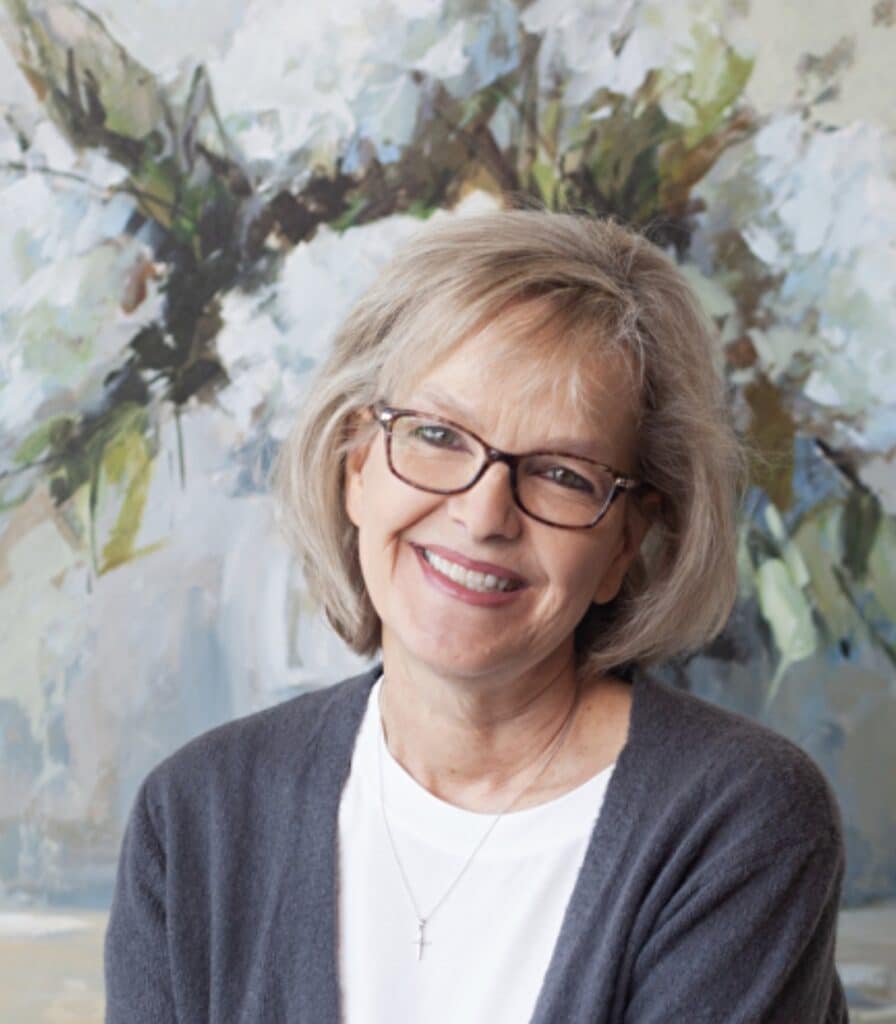
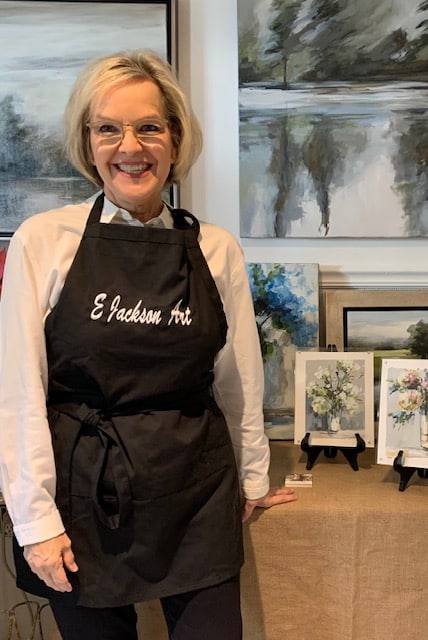
A self-taught floral and landscape painter, Jackson started her journey into creativity with an art class in her teen years. It wasn’t until much later that she fully embraced her passion for painting.
Born and raised in Macon, Ga., Jackson’s artistic journey took shape gradually. After obtaining a degree in advertising, she found herself working in a bustling Buckhead PR firm where she met her husband.
Upon starting a family, Jackson put her artistic pursuits on hold to focus on motherhood. Today, from her converted carriage house garage studio, she creates captivating works of art.
Discovering the artist within
Once her daughters were grown, Jackson found the time to delve into her passion for painting. She began honing her skills, initially starting with watercolors and eventually transitioning into acrylics; she now uses both mediums.
Over the past twelve years, Jackson has dedicated herself to her art full-time, tirelessly perfecting her métier through trial and error, self-exploration and occasional workshops.

Capturing Southern tranquility
Inspiration for Jackson’s artwork comes from various sources, whether it’s a place she’s visited, the picturesque landscapes of her surroundings, art galleries, design studios or even from pieces requested by clients.
Jackson finds comfort in exploring the scenic vistas where she’s lived and drawing from the unique beauty of each location. Her paintings are infused with personal significance.
“Many of the landscapes are reflective of where I’ve lived or visit often in the South which have special meaning to me. The coastal scenes reflect the Georgia/South Carolina coast or the Gulf in the Santa Rosa Beach area. The countryside pieces and pathways are inspired from when I lived in Franklin, Tenn. or visited North Carolina,” she said.
The painter’s preferred subject matter often revolves around hydrangeas. Her floral paintings exude a sense of serenity and harmony, drawing viewers into a world of lush foliage and vibrant colors.
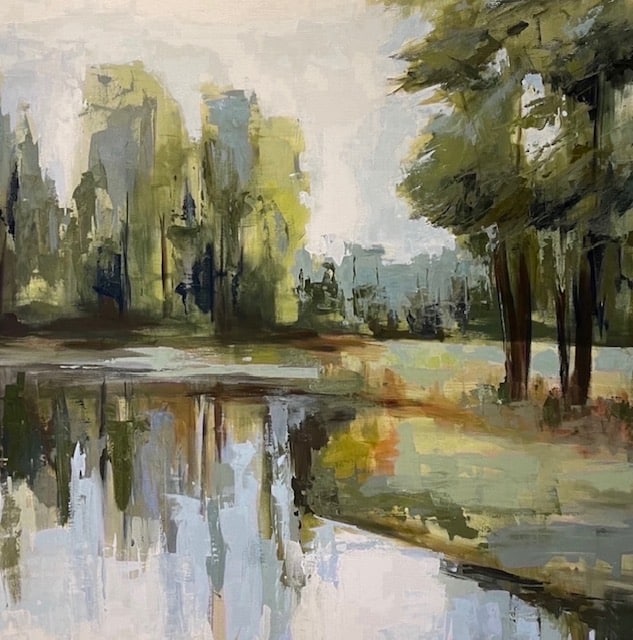
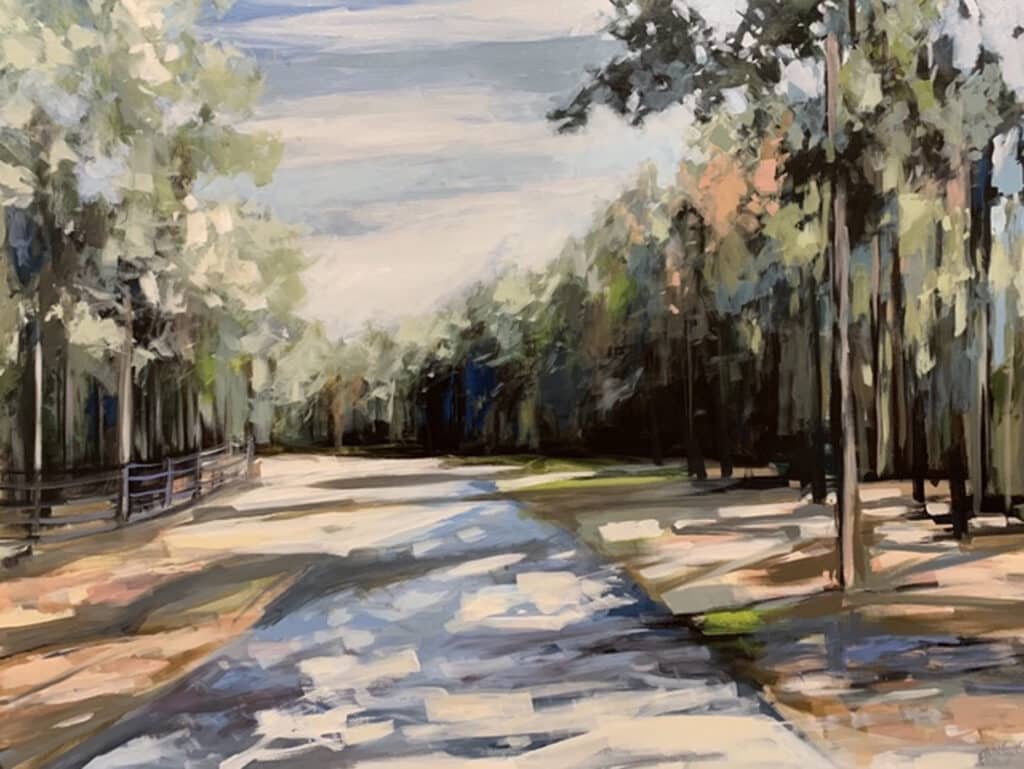
The space between realism and abstract art
What sets Jackson’s work apart is her distinctive style which she describes as abstract impressionism — a delicate balance between realism and abstraction. Through loose brushstrokes, palette knife sgraffitos and a harmonious blend of colors, she captures nature in a way that resonates with viewers, inducing feelings of tranquility.
“It’s not abstract to the point where you can’t recognize what you’re looking at. I want people to still identify with it, but it’s looser than a realistic painting. It’s like a transitional in between,” Jackson explained.
Embracing blue-green
Her signature blue-green palette, inspired by her love for the color green, has become synonymous with her artwork, sought after by collectors and interior designers alike.
It’s helpful that it’s a popular color scheme in decorating. Working with several interior designers, Jackson stays abreast of trends. People moving to Lake Oconee often commission work from the artist. Her shades of green and blue are ideal for lake houses.
“I’m trying to work myself into other hues. I have to keep those colors off my palette, or I’ll gravitate back to them,” Jackson said. She plans to explore different colors in new paintings and collect customer feedback received by the shops carrying her work.

Super-size
Jackson paints large canvases (48”x48”) as requested by designers. Though she was once “scared to death” of them, the large-scale pieces allow her to immerse herself in the creative process, granting her the freedom to express herself with fluidity and spontaneity.
She often incorporates texture into her paintings using palette knives, sponges and even unconventional tools like sticks from the yard, adding depth and dimension to her compositions.
A growing presence
Despite the demands of maintaining inventory for shows, her website, multiple galleries and interior design shops across Georgia, Tennessee and the Carolinas, as well as fulfilling commissions, Jackson remains dedicated to her craft. Her work ethic and perseverance have paid off, earning her recognition and admiration from art buffs and collectors.
Initially, it was challenging to get her artwork into stores. However, Jackson’s influence has grown in step with her social media presence. She’s paid her dues and today shops pursue her.
The artist is thankful to have built up her business. “I’m slowly trying to spread myself across the country,” Jackson revealed.
Although her daughters encourage her to take time off, Jackson finds it difficult. She’s in business for herself and feels the studio, just two doors away from the kitchen, calling.
A steady base of realtors keeps Jackson painting watercolor home portraits that they gift to their clients. They’re popular at Christmas, too.
As Jackson’s artistry continues to evolve, she remains grateful for the opportunity to share her passion with the world. With each painting she invites viewers to immerse themselves in the beauty of nature for a moment of respite from the chaos of everyday life.
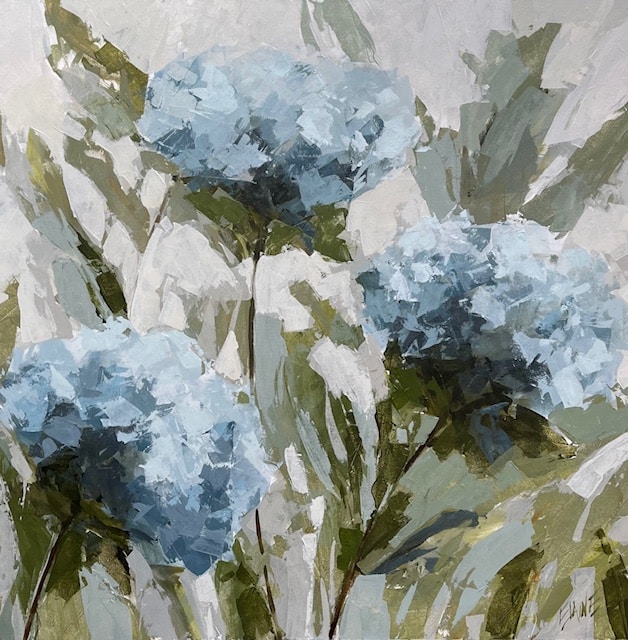
Framing the narrative
The cost of framing large pieces is so prohibitive, Jackson paints the edges of gallery-wrapped canvases so they don’t require a frame. This leaves framing up to clients; some like gold, others want silver or wood. Many prefer to keep the paintings frameless.
Jackson does frame some of her smaller pieces (24”x24”, or 16”x20”). Usually, she uses modern floater frames. They’re not too expensive and they elevate the presentation of the work.
Her watercolor pieces are normally framed, but the artist also keeps some in a folder. People can purchase them loose and select frames to fit both their space and aesthetic.
Everything old is new again
Recently, Jackson has been exploring antique stores in search of old frames. There’s a treasure trove to be found with intricate designs and aged beauty. The artist has identified a growing appreciation for blending vintage elements with contemporary decor. She loves the thrill of the hunt!
Jackson repurposes the frames for special paintings that she thinks are fitting. Their ornate, almost gothic appearance reminiscent of a bygone era finds renewed admiration.
Other than applying a subtle wash to tone down excessively dark gold hues, the artist prefers to leave the frames untouched, allowing their original splendor to shine through. This endeavor has proven fruitful; her ornately framed pieces quickly find appreciative homes.
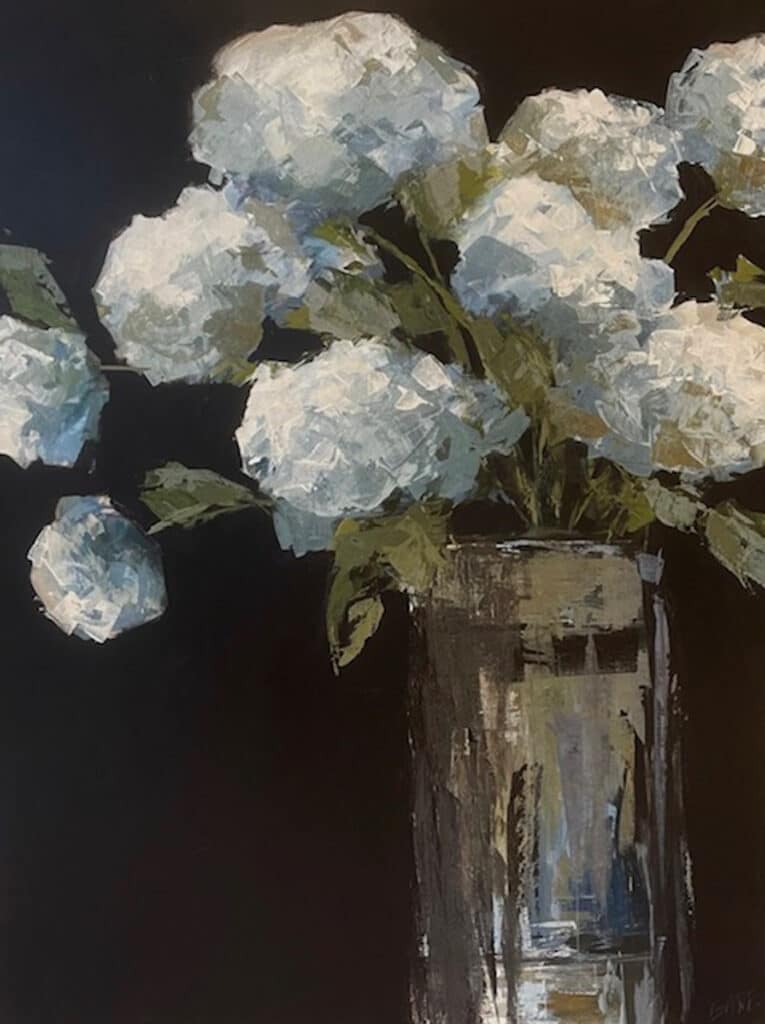
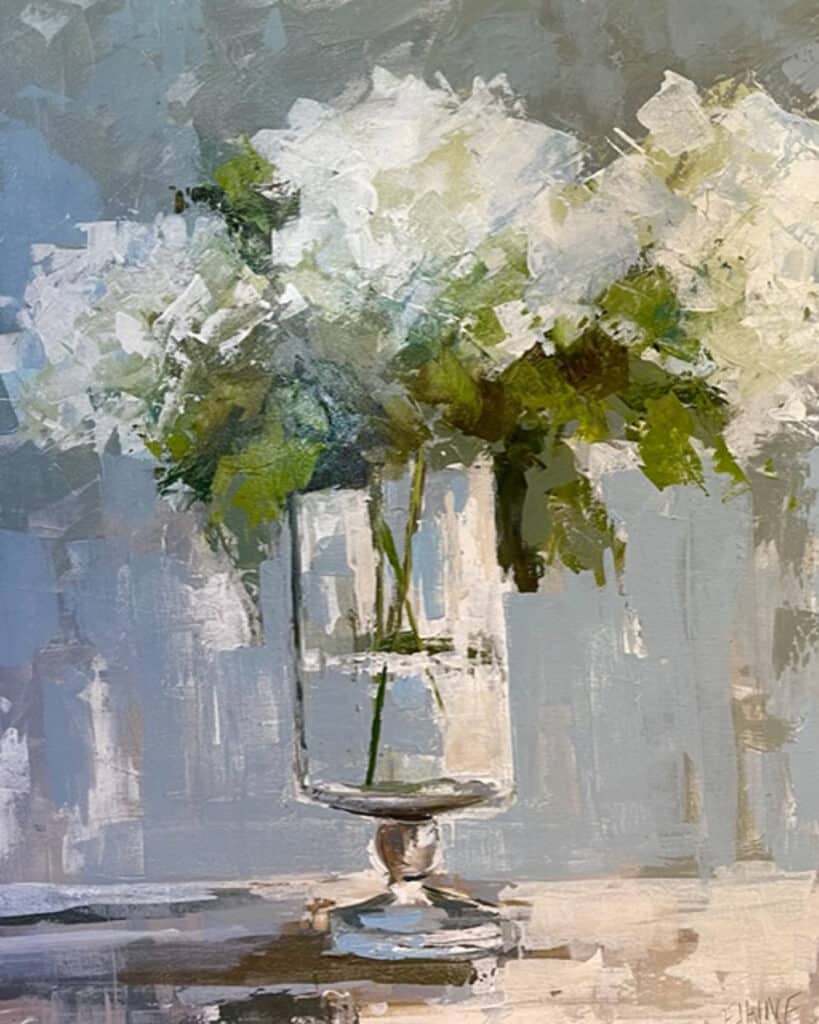
WAM
Preparing for art shows requires careful consideration. Jackson strives to offer a diverse selection of paintings in various sizes, styles and price points from $150 to $4,500, catering to the preferences of different patrons.
A mix of florals and landscapes — from small, intimate pieces to large, statement-making canvases — ensures there’s something for everyone.
The painter suggested a series of framed landscape paintings 20”x by 20” as a good idea for shows. Each one works as a standalone piece or can be configured in groupings. Instead of having to purchase one huge piece, people might get a few smaller ones to fit a space.
Jackson has been exhibiting at WAM since 2015, gaining a number of followers in the area. She appreciates the indoor luxuries and looks forward to client interactions.
“It has consistently been a good, well-attended show each year,” she said.
Find Jackson’s work
Those seeking to experience Jackson’s talent firsthand can find her work in galleries and design studios across the South. To inquire about purchasing a painting or commissioning a custom piece, visit her website at ejacksonart.com or follow her on Instagram @ejcolors.
Jackson’s artistic journey is a testament to the transformative power of creativity and the profound connection between artist and audience. Through her paintings, she invites us to pause and find solace in the timeless beauty of nature.
Purchase Jackson’s work in Georgia
- WebbMarsteller in Peachtree Hills, Atlanta
- Sunshine Village Art Gallery in Watkinsville
- Dogwoods Home in Clayton
- Ocmulgee Arts in Macon
- Julep Gallery on St. Simons Island
- Zeb Grant Design Home in Madison
Meagan Brooker
In her childhood days in Fort Oglethorpe, Ga., Meagan Brooker longed to paint the sky and clouds on her bedroom ceiling. Her earliest memories include a yearning to express her creativity.
The little girl who once begged her mother for art supplies and classes was first encouraged to pursue her passion and develop her skills by a high school art teacher.
“I was doing a Georgia O’Keeffe replica in oil pastels. She walked up behind me and said, “Whoa, you’re really talented!” You always remember those who encourage you to do what you love,” Brooker stated.
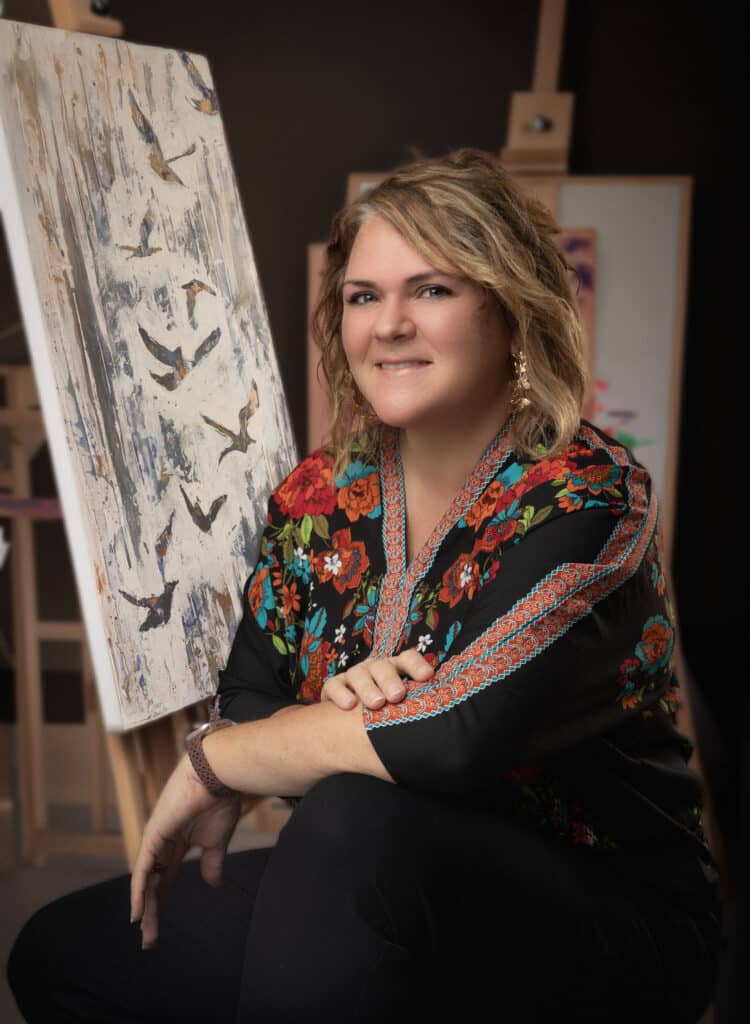
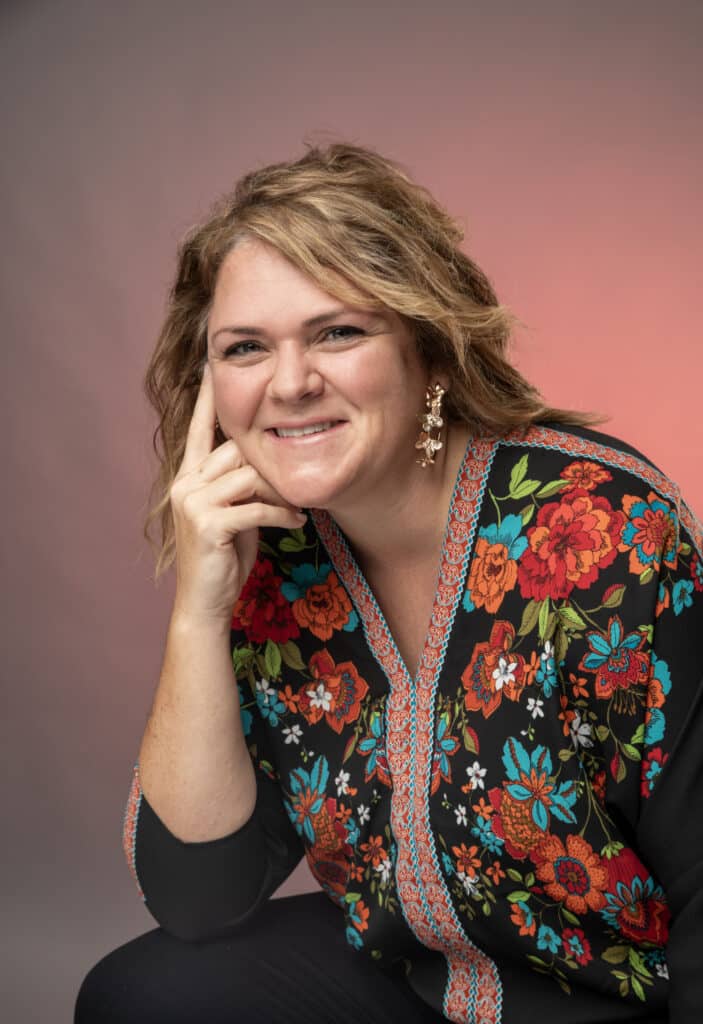
Despite an early penchant for photography, Brooker’s family encouraged her to pursue pre-med studies at the University of Georgia. “Use your brain,” they told her. “You’re smart, make some money.”
But Brooker realized she didn’t want to study science for four years, much less practice medicine for the rest of her life. It simply didn’t interest her. Conversely, shifting to art second semester caused her to flourish, feel divinely inspired and never look back.
Nurturing creativity
While her mom was supportive, her dad would’ve likely continued to endorse a medical school path had he not passed away when she was in secondary school. She majored in Art Education at the University of Georgia.
Brooker transitioned to Wesleyan School after teaching elementary art in Gwinnett County for two years and participating in a year-long mission trip to Kentucky. During her second year at Wesleyan, she began working towards a Master of Studio Art degree at New York University.
Brooker has been a freelance artist for decades. She currently resides in Duluth. She’s been teaching high school art and witnessing the growth of Wesleyan’s visual arts program for 17 years.
From photography and ceramics to drawing and painting, Brooker loves working with and teaching about all types of art. Painting with a plenitude of textures and washes of color is her favorite.
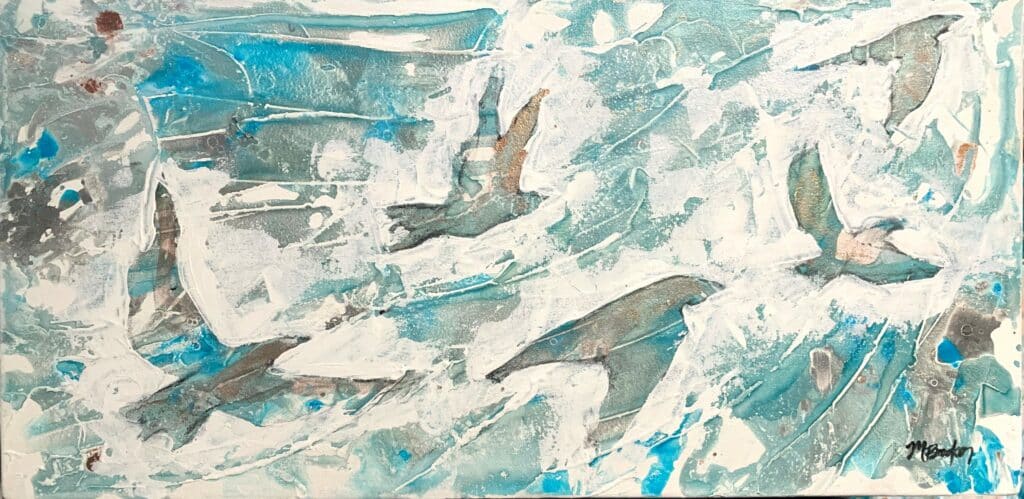
Art teacher by day, artist by night
Once her young sons have gone to bed, Brooker can be found painting in her home studio surrounded by her work, an easel, tables and storage shelves.
The industrious working mom laments a lack of time. She craves longer stints in the studio to develop more robust work, both conceptually and physically.
For Brooker, painting is meditative self-care. It takes her away from the tasks of her daily life, fulfilling a need for self-expression and recreating the world around her. She derives satisfaction from depicting on canvas what she’s experienced while traveling.
Imagination takes flight
Brooker’s fascination with winged creatures began with seeing Raphael’s cupids when she was young. Later, she became enamored with birds on a wire and recently, she’s been painting birds and butterflies in flight. To the artist, they represent hope and resilience.
Her work is a pictorial ode to her father’s passing with spiritual undertones. Brooker finds flying animals and insects enchanting because they’re harbingers of something bigger than us. The artist believes there is more to this world than what we know and see.
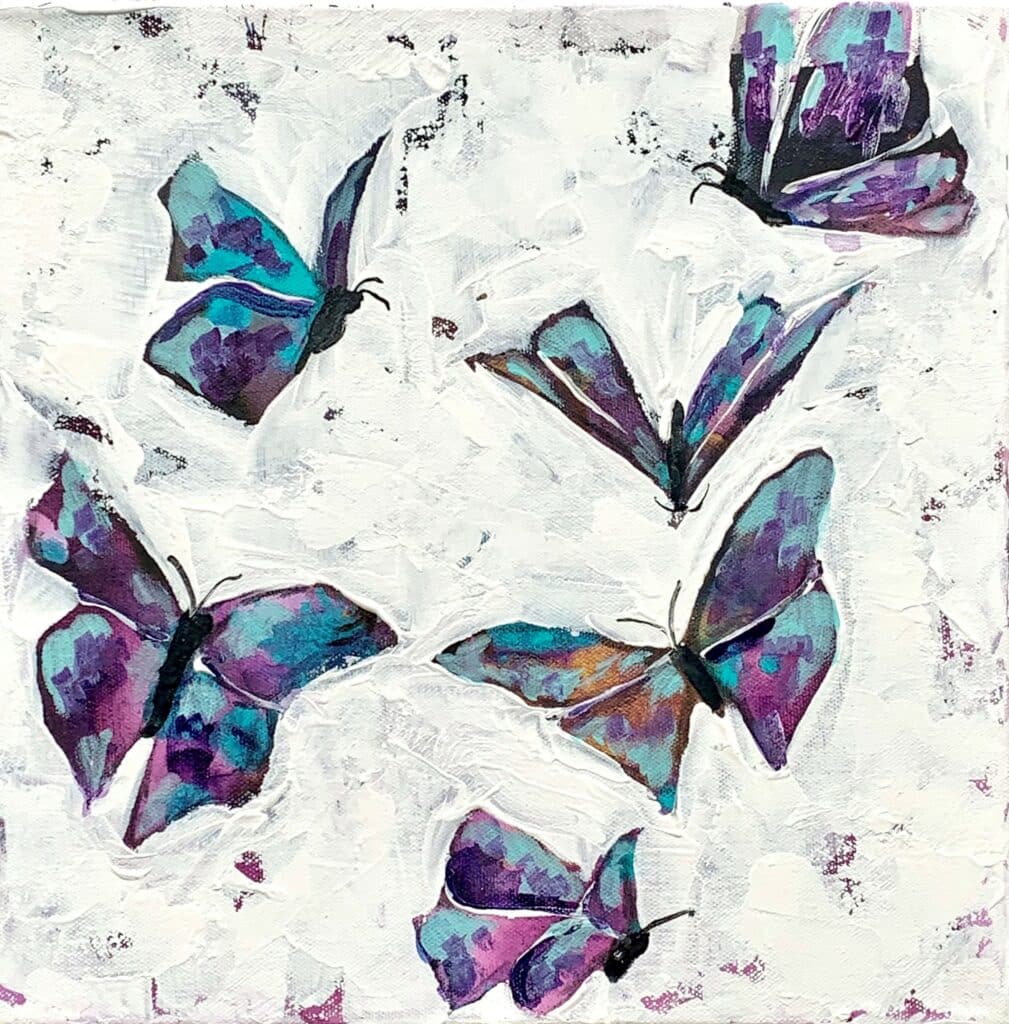
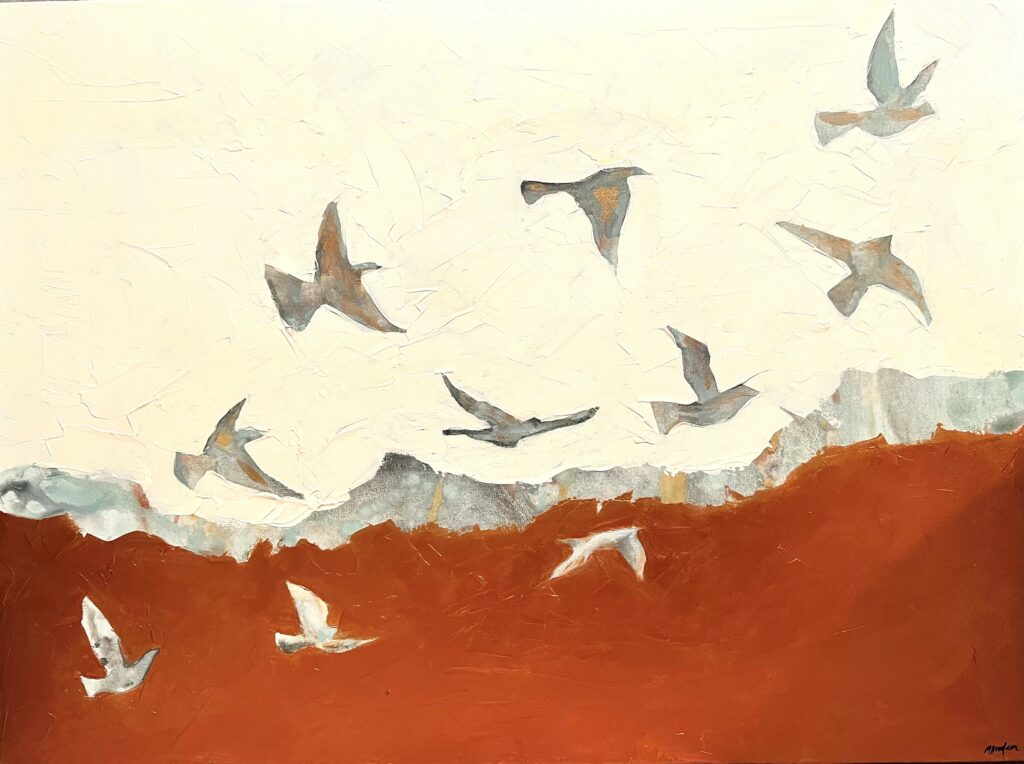
Little loves
Wishing to spread beauty, calm and joy in the universe, Brooker creates artwork that reflects her personal experiences, wishes and dreams.
“When clients are moved by the same sentiment, it is a beautiful, spiritual connection,” she said.
The artist calls her 3”x3” and 6”x6” canvases “Little Loves.” Inspiration for these fast-selling pieces stems from a sentiment, quote or Bible verse featured on them.
Reflecting on the chosen words inspires the colors, textures and patterns the artist uses to represent them. Seeing clients emotionally drawn to her work warms Brooker’s heart. It tickles her to know that some pray and meditate with her tiny paintings before them on mini easels.
Brooker’s art
Brooker produces whimsical, textured and painterly acrylics on canvas ranging in size from 8”x8” to 46”x60”. Most of her canvases are 20”x30”. She works primarily with thicker acrylic paints, spellbound by the effects of experimenting with washes to create layers of unpredictable textures.
Palette knives are her tools of choice when creating texture with thick body Liquitex acrylic and Golden high flow acrylics. Intrigued by the unexpected, Brooker described her process.
“I cover every canvas with a layer of acrylic washes [water dotted with different colors of acrylic that bleed like watercolor and create a textural background] and however they land, color and texture-wise, I build from that as I’m inspired. I love that you don’t really know how it’s going to turn out at first,” she explained.
Robin’s egg blue, Payne’s gray (a dark blue-grey), golds, teals and some neutrals dominate Brooker’s palette. She’s drawn to abstraction because it’s harder than it looks, she said.

“Travel far enough, you meet yourself.” – David Mitchell
Traveling inspires Brooker’s landscapes. Working from pictures taken on her trips, she paints sceneries that captivated her, aiming to replicate their loveliness and the emotions she felt there.
“Italy is my heart,” she said, recalling her Cinque Terre series. She also painted an Ecuador series, enthralled by its mountains and verdant hills.
Wesleyan Artist Market
As an art teacher, Assistant Director of Fine Arts, Head of Visual Arts and a veteran exhibitor, Brooker has an insider’s perspective on the market. She sees how it comes together full circle.
She witnesses parents volunteering to put on this hugely successful event, giving generously of their time to the school. In turn, the faculty has more funds to better support students.
“It’s a beautiful testament to how much they care about the school and our mission. I’m very thankful,” she said.
Find Brooker’s paintings
Through her dedication to art education and her unwavering commitment to her craft, Brooker inspires others to embrace their creativity.
To view and purchase Brooker’s work, find her on Instagram @meaganbrookerfineart.
Learn more about Meagan Brooker in this episode of the Peachtree Corners Life podcast.
Related
Arts & Literature
Wesleyan Artist Market 2024: Meagan Brooker
Published
4 weeks agoon
March 28, 2024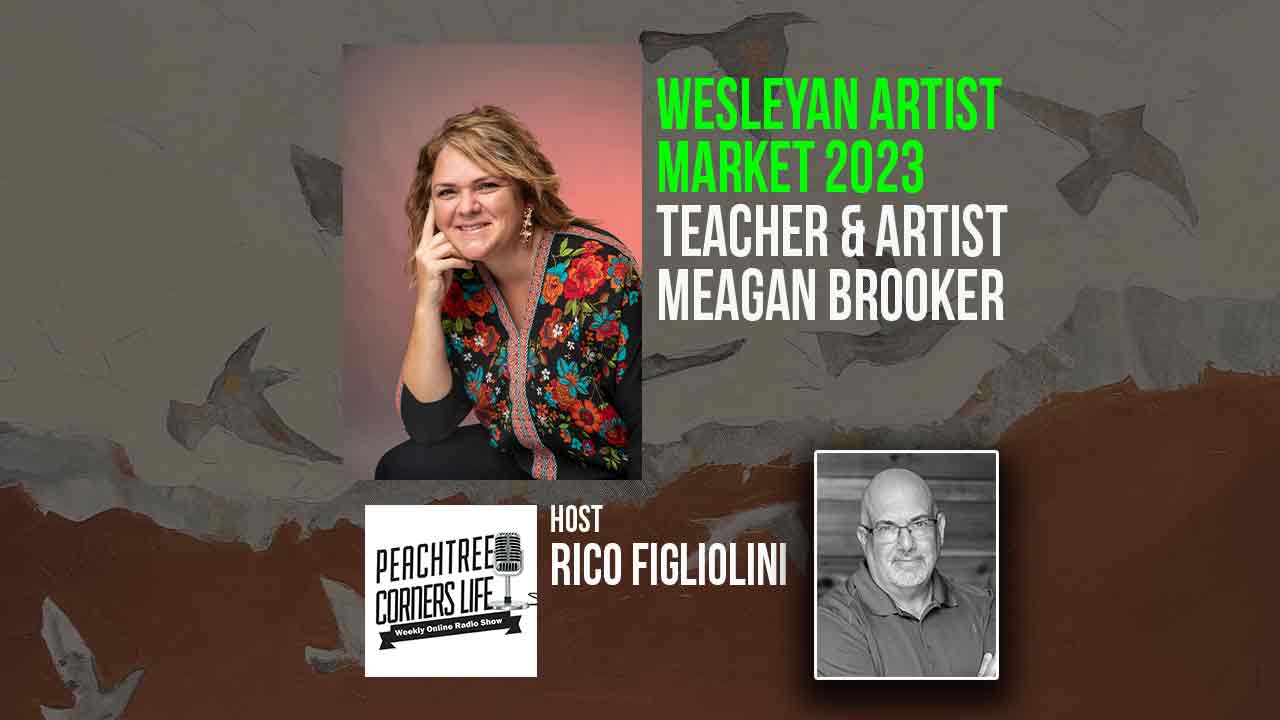
The Wesleyan Artist Market takes place in Peachtree Corners on April 26-27, 2024
Listeners are taken on a journey into the colorful art world through the eyes of high school art teacher Meagan Brooker. With 17 years of experience at Wesleyan School in Peachtree Corners, Brooker shares her passion for creativity, sharing how art has become a form of therapy and a source of inspiration in her life. From discussing her artistic process and inspiration to highlighting the importance of art for mental well-being, Brooker’s infectious enthusiasm for art will captivate and inspire listeners of all backgrounds. Brooker’s art will be displayed at the Wesleyan Artist Market 2024, April 26-27.
Tune in to discover the transformative power of creativity and art in this enlightening and uplifting Peachtree Corners Life Podcast episode.
Timestamp:
00:00:00 – Introduction of Artist Meagan Brooker
00:01:32 – Teaching Art at Wesleyan School
00:04:00 – From Science to Art: Following My Creative Passion
00:08:42 – Balancing Creativity and Exhaustion
00:10:18 – Painting as Meditation and Process
00:13:53 – Tuscany Landscapes to Inspire Artists
00:17:29 – Finding Inspiration in the Unexpected
00:20:32 – The Healing Power of Art in Challenging Times
00:23:16 – The Pros and Cons of Social Media for Artists
00:25:49 – Embracing Digital Art Tools and AI in the Creative Process
00:29:08 – Exploring AI’s Role in the Creative Process
00:31:23 – Closing
Podcast Transcript
Rico Figliolini 0:00:00
Hi, everyone. This is Rico Figliolini, host of Peachtree Corners Life. This year, this month, today we’re doing an interview with an artist that’s going to be at the Wesleyan Artist Market, Meagan Brooker. So let’s say hi to Meagan. Hey, Meagan.
Meagan Brooker 0:00:13
Hello.
Rico Figliolini 0:00:14
Thanks for being with us. Appreciate it. Thank you for being with us. Before we actually get into all of this, I just want to say thank you to our sponsor, EV Remodeling, Inc. They do a great job when it comes to remodeling, design and build, start from scratch up. Eli, him and his family live here in Peachtree Corners, does a great job. Lots of people know them. Anything from your bathrooms and kitchens to your whole house almost. So check them out at evremodelinginc.com. We appreciate the support of these podcasts. So now let’s get right into it because we’ve done this, I just did this interview a little while, a few weeks ago with two student artists that are going to be featured at Wesleyan Artist Market. Their stream is actually going to happen Wednesday. For Meagan and I to know you all that are listening won’t know which Wednesday that is, but it’s going to be on a Wednesday. Actually, before we go to press with the next issue of Peachtree Corners Life magazine, which has three profiles, including Meagan, of the Wesleyan artists, three of the artists that are going to be there. So this is a compliment to that. We’re going to be talking a bit about art and what inspires Meagan. So let’s get right into it. Meagan, why don’t you tell us a little bit about yourself and maybe how you started at Wesleyan.
Meagan Brooker 0:01:36
Yeah. So I teach at Wesleyan school. I teach high school art. I teach all levels of AP photography, and I’ve been there for 17 years, which makes me feel very old.
Rico Figliolini 0:01:51
You’re not, though. You look fine.
Meagan Brooker 0:01:54
Thank you. So I went to the University of Georgia and went after getting my degree in undergrad of art education. I taught elementary art in Gwinnett county for two years. And then I did missions work for a year, actually, and was looking for a high school job because I thought the idea of the challenge of high school would be really interesting. And, yeah, I just love my job and I love Wesleyan. And I’m very grateful to be there because obviously I’ve been there for 17 years.
Rico Figliolini 0:02:29
Yes, it’s a great school. Wesleyan school is in the city of Peachtree Corners, and they do a fantastic job and they’re growing. I mean, they’re in the middle of actually a building project right now for their STEM building. So lots going on at Wesleyan. This is just one facet of what they do. So you’ve been there 17 years and you’re teaching high school students, I believe the high school, the upper level class. Upper school, yes. In particular, what are you teaching at this point? What subject or mediums are you working in?
Meagan Brooker 0:03:01
So currently I’m teaching all levels of 2d art. So drawing, painting, mixed media, anything that’s 2d from foundations all the way up to AP, the AP level, which is kind of college credit courses. And that includes AP photography. Previously I taught photography and way back in the day I used to teach 3d as well. But I love now that I get to specialize in two d. And then we have amazing teachers who teach focus on photography and focus on 3d. So we have a great team.
Rico Figliolini 0:03:33
Excellent. Cool. Let me ask you something, because as we grow up, as we’re young and we’re getting into school and we’re in elementary and middle school, we start discovering ourselves a little bit, right? We start discovering what we like, what we don’t like and stuff. Of course, people around us, including parents, may sometimes tell us what we should like and we shouldn’t like or what we should become. I know that you inspired early on to be an artist, to go down that route. Well, maybe not to be an artist, but to go down the route of the arts versus the science. So tell us, what inspired you? At which point did you decide you wanted to be creative versus being, let’s say, a doctor or something?
Meagan Brooker 0:04:17
Yeah. Well, that’s interesting, actually. I tell all my students, like, follow your innate gut and what fulfills you and stirs you up and makes you want to do more. I, from a very young age, was always wanting to paint, create, take classes, paint my ceiling in my bedroom, even though my mom wouldn’t let me paint furniture. I was always wanting to create or create my own space or do something creative. I had a very fast working creative brain and I came from a small county up in north Georgia, and there weren’t many opportunities in the arts. So in high school I had a great art teacher who was the first one who looked at my work and said, you know, you’re really talented. And I was, you know, so I got that encouragement and that fed in, which made me want to work harder. It made me want to do more and try more and get better. So I actually went to college and started in premed because I had good grades and was smart and my family was like, you, listen, go make some money. Don’t become a teacher.
Rico Figliolini 0:05:27
Not good money there.
Meagan Brooker 0:05:30
So I started off in premed and I just was bored to tears. And it was not life giving anyway. So I decided to switch to art and have never looked back ever since then. My family sometimes wishes I might have, but they see how life giving it is for me now and how innate it is and how much I’m able to do with the creativity. So it’s come around.
Rico Figliolini 0:05:56
So you’ve never really looked back and said, maybe I should put my brushes away and do something else.
Meagan Brooker 0:06:02
No, it’s too natural. I have too much of the creative and too much to put out there to stop. I’m not really that great at anything else either. Have too much fun with it to stop now.
Rico Figliolini 0:06:18
Right? Okay. And I can appreciate that. My parents wanted me to be an accountant, hated numbers, could never do that. And just not for me. My brain didn’t work on that side for that. But teaching art, this is one of the things I learned from my youngest, right? He says to me, I asked him, I said, what do you want to be? He says, I’d love to be a writer. I want to write. I want to write novels and stuff. So he’s creative, but he doesn’t want a job, that he has to write a lot during the day, because then all his creativity is gone by the end of the day. So how do you work that? How do you balance. It’s a life balance, right? Work life. How do you balance that creativity with the work that you do all day long with other kids? How do you do that?
Meagan Brooker 0:07:05
Honestly, that is probably the toughest part of my job. And I have two young boys, so that to complicate the.
Rico Figliolini 0:07:14
How old resources.
Meagan Brooker 0:07:18
One’S twelve, he’s in fifth grade and one is eight. And they go to Wesleyan with me, which is also a huge blessing. When I started off in art education and I got into the courses and started doing the practicum teaching, I loved being able to impart the knowledge of creativity and the natural working of all of the brain work that working with your hands does in every way. And it’s not about teaching methodology to me, as much as it is like pulling out this natural creativity. And I was always fascinated with art therapy. I considered studying that, but I think art is very much a natural therapy. And there’s so many studies about how when we’re working with our hands, how our brains calm down, they can think better. They’re clearly so. Even just a 30 minutes break in the middle of the day or an hour break to work with your hands and not have to just use a different part of your brain is so good for anybody. You think about how it works with four year olds. It’s the same with 80 year olds. Being able to use my creativity during the day, it is exhausting because I feel like being asked 20 questions every five minutes. I do come home depleted, but at night, when the boys go down, when I can, I will go down and just let it all out on canvas. I will say, currently, my work is not the most conceptual. It’s more reactive, but it’s kind of more guttural and things that I. It’s emotional in a way of things that I’m reacting to in my current life. And I feel like most artists do that. It’s like where you are, your work is breathing out of where you are.
Rico Figliolini 0:09:17
I think that makes sense, right? Because inspiration is in the moment when you’re doing these things. It’s not like most artists plan these things out. Sometimes you may have in your head, but you’re working in the medium you’re working in. It could appear different, and you’re trying to rough it and do different piece from it. When you are like that, when you have to be in your space, if you will. I know writers, for example, will write with the door closed, if you will, and they know that pages and chapters will go away at some point because they’re just getting into that space. Do you find yourself doing that with art? How’s the process? Do you sketch first and then go to the medium that you choose for it in the paper or the surface that you want to put it on? How do you do that part?
Meagan Brooker 0:10:04
That’s a really good question. I love sketching and planning in my current stage, just don’t have that much time. So I tend to work out my process as part of the process and build up my layers and build it up until it’s a complete being. So the art is very much a process as opposed to being a super planned, which is my personality, more free spirited by nature. And so sometimes I will write verses or quotes or things that are on my mind kind of in the canvas as I’m going as a meditation. And then I’ll build the color, texture, and design up as part of that meditation of whatever is on my heart at the time. And the art will kind of come out of that longing or prayer or moment that I’m having there. I do small ones that are, I call them little loves, but they’re all based off of an attribute or a thought, like prayer, contentment, love. That they’re kind of prayed over in a way.
Rico Figliolini 0:11:21
I know there’s one behind you, but I put one of your pieces on the feed right now. Tell us a little bit about that one.
Meagan Brooker 0:11:29
This one. If I had a gallery show, which I hope to one day, I would call it something like an affinity for winged things. I’ve always had loved angels. I love birds, butterflies. There’s something about them that represents such hope and freedom. And so the past few years, I’ve done quite a few butterflies. And so the one on the screen here, I love the color tone in it, but I recently started adding in kind of a duo tone background with the gold and white. That almost represents a duality of. It. Kind of brings in a contrast of emotion, if you will.
Rico Figliolini 0:12:11
I see two different color spaces. A border, ragged border. Same way with. I see this. Right. This is another piece that you’ve done. Same type of ridging, same type of look. Duality. Two different worlds, two places. What were you doing here in this one?
Meagan Brooker 0:12:33
Yeah. Similar to this one here behind me. I feel like there’s always a tension in our humanity of light and dark. Right. There’s a tension we’re pulled between right and wrong, light and dark, hope and failure, or anything that could pull us down easily if we don’t pull toward the light. So when combining these hopeful creatures like birds and butterflies, with that tension, to me, it’s this representative of choosing the hope, choosing freedom, choosing to do what you can do, to move yourself to a higher purpose and to truth and to light and to all the things that God offers us in this life. So it’s just kind of representing like, yes, sometimes life’s really hard, but there is hope.
Rico Figliolini 0:13:29
Let’s go to something a little different that you shared with us. This one, it’s a bit different than the other two. Can you tell us a little bit about this one?
Meagan Brooker 0:13:39
Yeah. This one was inspired by, actually, Tuscany and the green hills of Tuscany. I love traveling. I love Italy, especially has my heart. I’m actually taking a group of the high schoolers to France this summer, and I’ve not been this part of France, so I’m excited about that. But I often will recreate images or know certain landscapes of pictures that I take when I’m traveling. Not all overseas, some here, and recreate them. And so this is kind of representing, loosely, the villas that you’ll see dotted all over the hillscape. The landscape of. And Tuscany is dotted with farmland everywhere. And these are just hilly wineries and orchards.
Rico Figliolini 0:14:29
So this was done in acrylic? Correct. And you chose that over. Do you work mostly in acrylic now, or do you work in.
Meagan Brooker 0:14:38
I love oil, love watercolor. I love mixed media. For artist market, I choose to do acrylic in the same vein. And I hope that you don’t hear this as an excuse is more. It’s just a stage of life where it’s quicker. The acrylic, I’m able to move quickly and work quicker and layer in it and get the effect, because I don’t necessarily have time to sit and make 30 oils in this stage of life. So acrylic offers me the ability to work a little quicker in it.
Rico Figliolini 0:15:10
Okay. And this particular piece, I mean, they’re all relatively big pieces too, right? Like 30 x 30 or something along those lines.
Meagan Brooker 0:15:17
That one’s huge. That one is, I believe it was 40 x 60. It’s about the size of this one behind me. And a friend bought it for their piano room in their house. So it looks really good on that big wall.
Rico Figliolini 0:15:29
Nice. When people do buy your stuff, do you recommend certain framings for your pictures, or you let them do their own thing?
Meagan Brooker 0:15:37
Usually they have something in mind that fits their aesthetic, but I love float. Personally, I think float frames look so good.
Rico Figliolini 0:15:46
So when people buy your paintings like this, I’ve asked this of other artists, how do you feel about it? You’ve done it. It’s not like it’s the 30th piece that you’ve done of the same exact thing. So you’ve spent your time doing it, and it’s leaving you. It’s almost like a baby. It’s going away. It’s going to be in someone’s house. How do you feel about that?
Meagan Brooker 0:16:09
This new series with the duality are some of my favorite new ones. And to see one of my favorite parts of doing work for clients, when people are choosing work, like at artist markets as opposed to galleries or collected and stuff like that, is seeing people’s reaction to it and why they choose it. That is such a precious moment, because I think every artist, or most artists at least, pour so much of themselves into it. And to your point, some of them have trouble letting go of it because they become precious. But when they stop in their tracks and have a visceral moment of like, oh, my mom just died, and she loves birds, and that’s her favorite color, and they’ll just start, my goodness, there are tactile things that they will hold on to that become meaning to them, that may not be the eye assigned to it, but it doesn’t matter. That’s what the beauty of art is. The expression of the color, the movement, the feeling, and the hope that people will hold on to.
Rico Figliolini 0:17:16
Wow. Yeah. I can’t imagine that feeling. I’m not an artist, so I can’t imagine that. I’m a graphic designer, but not an artist, so I don’t know how that feels. I do know how it feels to put together a magazine and send it to the printer and then have it come back in a palette of, like, 10,000 copies or something. I don’t know how that feels.
Meagan Brooker 0:17:39
That’s a relief, is what that’s called.
Rico Figliolini 0:17:42
Yes. In fact, I have two deadlines this week, so it’s going to be a relief when this week is done. Yeah, it’s just one of those crazy weeks, actually. So we talked about keeping fresh and continuing to evolve. Well, actually, we didn’t talk about evolving as an artist. You touched upon it a little bit. But how do you do travel? You do find, like you said, Tuscany was a great, beautiful landscape to be inspired by. You can’t go wrong with Tuscany. Right? Do you find inspirations in some of the simpler things in life or places that you didn’t even think inspiration would come from, or moments? Does any of that happen sometimes?
Meagan Brooker 0:18:23
Yeah. Sometimes I think back to COVID, and we were so limited, and I’m a mover and a shaker. I don’t sit still well to a fault. And so having to sit still kind of shook me. But I found myself grabbing my camera and going out in the beautiful spring light and catching these abstracted flowers that were blooming across the street and the way that the light hit them or life, noticing trees in our yard that were blooming. And I hadn’t noticed how beautiful they were at the time. Things that I hadn’t stopped long enough to appreciate. And, of course, the beauty of my children and their just innocence at their ages. And so just taking time to stop that makes me want to highlight the beauty of life as opposed to the hardship. Because anytime we can have a moment, and if my art is a moment to stop and be like, okay, let me just take a beat and find some hope and find a little moment of truth and hope in our day.
Rico Figliolini 0:19:33
Okay. COVID was an interesting period. Right? It was a bad time for many families, but it was also, in some ways, a good moment in time because things stopped. We were forced to stop what we were doing. So it was so bad at one point that if you remember the supply chain issues, ships stopped delivering, and in fact, the sea woke up more. The creatures in the sea, the whales, things were happening, air was a little cleaner. It was just different time. Right. So I can see that quiet. But you’re basically forced into doing things that we weren’t. We were forced to stop doing what we’re doing. The inspiration, I guess, can be found in many places. You’re teaching lots of kids through the years, 17 years of teaching at Wesleyan. I’m sure there’s been talented, very talented kids across that time frame. Is there any story, inspirational time, particular student or group of students or class that you felt was a moment that you want to remember? Maybe that inspired you, maybe that inspired other kids. Maybe there was something going on at that moment, or maybe even creativity out of students that you didn’t think would be creative because maybe art wasn’t their thing.
Meagan Brooker 0:20:54
Well, for one thing, that just because we came out of the conversation of just talking about COVID is how important art was to the ones who had it during that time. Teaching hybrid was the hardest thing I’ve ever done. And when we were, like, on camera and trying to teach art from home and all of that. But I have multiple stories of students who. Art was their lifeline at the time, because whether home was not safe for them or whether they just needed to be out and be social or whatever it was, art was their way of their identity, of finding some way of expression that pulled them out of the anxiety, the mire, the scariness, the loneliness of the time, and a way to express themselves and kind of think outside of themselves. When you’re so glued to your phone or your computer trying to do a thing, art pulled them back out. So that was a beautiful thing and a testament to the purpose, I think, of our dedication, and I think what comes to mind, and I’ll shout out to my current AP art class, who are just, they’re so much fun, and we’re actually having our art show next week, so I’m excited about that. And they’re so creative. But I think that in this culture of, again, what we’re seeing post COVID is a lot more anxiety, a lot more pressure, a lot more peer pressure. The social media is out of control, and culture has a lot of expectations. And I think that what is beautiful is seeing the kids respond to these pressures through their art and subverting them with truth and with showing their own personality and identity in a way that they wouldn’t in social media. So their own personality and their truth is coming out. So they’re becoming more confident through their expression of art in a way that they wouldn’t without it. Right. So it’s like, oh, I am good at something.
Rico Figliolini 0:23:01
Right? No, I get where you’re going. You’re right. I could see that. But I can also see social media is good and bad. Right? Instagram, TikTok. I mean, there’s different various levels. If you allow yourself to scroll for 30 minutes, you’re losing a bit of your life. Maybe. But there are artists out there that actually share online also, and they use that medium to be able to share their art, whether it’s ceramics they’re doing or whether it’s actually watching them create something in the moment. Yeah, because that’s TikTok. I mean, does that. Right. Instagram, to a lesser degree, I think. But you could be watching an artist, a street artist, or just an artist in a studio painting, sketching the whole process for an hour or two, which is kind of interesting, right? Because you get to see the creative process. Most people don’t see that. They see the finished piece. They don’t know what Meagan Brooker to make that piece or what. Brie Hill, who was one of the students I interviewed, what it took her to make a painting and what she invested in that painting. Or Esther Cooper, who’s the other student I interviewed who does creative pastries. Right. That’s a whole different long. There’s no longevity to that. It expires at some point, you either eat it or it goes bad, but in the moment, it’s a good looking piece, maybe. Right. Talking about 3d art. More than that. Right. The scent of it and stuff. So I could see how social media can be helpful in some ways with some students.
Meagan Brooker 0:24:33
Yeah. I think with social media, we have so much at our fingertips now we can appreciate art in a whole new way, because, like you said, you can see the process. You can understand it more, but it also makes you want to try more. And there’s always going to be cynics. There are going to be people who will try to poke a hole in it. But I think we will be students until we die. I think that’s part of the creative part of teaching. Like, we always have more to learn. And so that’s what’s so fun about social media, is being able to go on and try something new or to see new work, because we’re to be inspired by something outside of us which broadens our perspective and opens our worldview a little bit.
Rico Figliolini 0:25:22
Yeah. Now, just to stick with technology a little bit, because there are students that use Photoshop, procreate, other digital products and software where you can create online in layers, brushes. We create your own brush palette, if you will. Do you delve into any of that? Do you see students using that as part of the process of what they’re doing? Are they using it even to pre plan a physical, tactile piece of art? What’s the final piece?
Meagan Brooker 0:25:59
It’s such a big question right now in the art world, and my co worker Drew Phillips has actually done a lot of research and given some talks on this. I currently do not teach any AI in what I am teaching, but I see the value of. Well, also I will say there’s inherent AI almost in everything now, like in my AP photography, and know there’s always the option of generative fill. But AP doesn’t allow any type of AI, but I think the use of it for know. So speaking of Rehill, she’s one of my students. She’s amazing. She just did with a girl being lifted up by doves with a sheet and ropes. That’s hard to take a picture of. She just finished it yesterday and it’s stunning. So maybe we can do a recap and show the finished piece. Not yesterday, today, but it’s hard to take a reference picture for that, to get her full concept in there. And we made it happen. But you could put that kind of prompt into AI and have it kind of create a reference for you, but then you are drawing it. So there’s a lot of debate about that and the crossover of what’s allowed. And, but, and there’s a lot of people who think that AI is going to take over a lot of jobs. But I’ll tell you, and this is coming from conversations with people who are working with Microsoft, AI creatives will never be out of a job because AI needs creatives to be able to create the prompts to do the job. And so the people who can think outside of the box and creatives, there will always be a place for us.
Rico Figliolini 0:27:45
Yeah, there’s so many forms of AI too, right? There’s language based, generative, there’s very various levels of AI. So you’re right though, because you need to be able to, I’ve played in it a little bit as far as writing and stuff like that, and even dolly and some of the visual elements and even a different form of sora, which is more video based. Right. And it’s not everything that people make it out to be. It takes the process of doing it almost, like you said, in some ways you have to be an artist to be able to pull out from that anything artistic that makes sense. Yeah. So it’s not as easy as people think. I get that question sometimes. Can’t you just do this in Photoshop? AI is in there. It’s like, no, you can’t just do that. You have to really think about what you’re doing here. It’s never going to look like what know, you could go into AI and you could go chat GPT and Dolly and tell it what you want and say, good, close, you got to where I need it. Add this and this, but don’t remove that and it’ll give you something completely different. So I know the prompts might be a little, you have to work the prompts the right way and stuff, but yeah, AI is a good tool to derive inspiration from. I think I agree with you there. You’re going to need creative people still, but I’m sure that’s still within the next five years that probably will be part of being taught in the creative process. Right. How to use AI as an intern or apprentice, if you will, for yourself in some ways. So you’re going to be at the wesleyan artist market. You’re going to be showcasing some of your work. I’m assuming some of the work that I showed, that we showed may be there. What type of work will you be actually showing at the show?
Meagan Brooker 0:29:33
Yeah, I’m doing some more of the, like what we were talking about with the dual duality and kind of playing around with that more, trying out some new subjects and content, but mostly that. But I want to try out some landscapes and build in some more looser sunset sunrises along with the birds and butterflies and see what I can turn out there.
Rico Figliolini 0:29:59
Cool. Anything you want to share with us that we haven’t touched base, I really.
Meagan Brooker 0:30:06
If you haven’t been out to the artist market, I highly recommend it. Okay, again, I’ve been at Wesleyan for 17 years, and I’ve been displaying at the artist market for 17 years. And believe me, I’ve grown a lot. I would be embarrassed to show you what I sold the first few years. I think my first year was actually, I taught ceramics, and so I did some ceramics, but I’ve grown a lot. But the funds of the market come back to the students. So it funds the fine arts and so the marching band, the visual arts, the theater, and so it comes back to the students there at Wesleyan. But beyond that, it is such a high level event put on by volunteers from the school, which is almost hard to believe because it’s such a professional looking event and it’s indoors. It’s one of my favorite things that we do throughout the year and I’m so grateful for those who put it on. So come out to see us. It’s a really fun event for the family.
Rico Figliolini 0:31:10
It’s going to be April 26 through the 27th, so that Friday, Saturday, and if you want to find out about it, it’s Wesleyan artist market. Just google that and I’ll show right up. Do you want to leave a last maybe word for any aspiring artists or educators? Anything you want to leave advice for them before we end the show?
Meagan Brooker 0:31:32
Yeah, I think if you feel like the need to create, whether that be writing, singing, writing out songs, it doesn’t matter if you’re good at it. The act of creating is fulfilling and there’s a reason that you are stirred to do it. And I think personally, I think that’s God working in you to bring you to a higher light and a higher purpose. And so just do your thing. It doesn’t matter what everybody else thinks, as long as it’s for you and for him or for whoever else you want to see it. Just let your light shine.
Rico Figliolini 0:32:03
Cool. We’ve been talking to Meagan Brooker. She’s a 17 year veteran teacher at Wesleyan school, teaching high school kids about art, and she’s going to be showing at the Wesleyan Artist Market. So stay with me for a second, Meagan. I want to just say thank you to our sponsor, EV Remodeling, Inc. Does a great job design, build home remodeling, kitchen, bathrooms, everywhere that you can think of. Eli and his family live here in Peachtree Corners. They’re just wonderful people. You should check them out. Evremodelinginc.com. So check those out and thank you, Meagan. I appreciate you being with us.
Meagan Brooker 0:32:38 Yeah, my pleasure.
Related
Read the Digital Edition
Subscribe
Keep Up With Peachtree Corners News
Join our mailing list to receive the latest news and updates from our team.
You have Successfully Subscribed!

Exploring Israeli Innovation in the Smart City Sector with Einav Gabbay [Podcast]

Georgia United Methodist Foundation Announces Changes to Finance Team

BRACK: Peachtree Corners to lose Peterbrooke Chocolatier

North American Properties Revitalizes Avenue East Cobb

Spring Voting Will Determine Important Gwinnett School Board Elections

Local Non-profit Boy With a Ball Announces Dates for Upcoming Conference

Local Non-profit Boy With a Ball Announces Dates for Upcoming Conference

Spring Voting Will Determine Important Gwinnett School Board Elections

BRACK: Peachtree Corners to lose Peterbrooke Chocolatier

Georgia United Methodist Foundation Announces Changes to Finance Team

North American Properties Revitalizes Avenue East Cobb

Exploring Israeli Innovation in the Smart City Sector with Einav Gabbay [Podcast]

North American Properties Secures 3 New Brands for The Forum

April/May Events Going on at Gwinnett County Parks

Light up the Corners [Video]

Capitalist Sage: Business Leadership in Your Community [Podcast]

Cliff Bramble: A Culinary Adventure through Italy

Top 10 Brunch Places in Gwinnett County

A Hunger for Hospitality

THE CORNERS EPISODE 3 – BLAXICAN PART 1

Top 10 Indoor Things To Do This Winter

The ED Hour: What it takes to Remove Barriers from Education
Peachtree Corners Life
Topics and Categories
Trending
-
Faith1 week ago
Georgia United Methodist Foundation Announces Changes to Finance Team
-
Business1 week ago
BRACK: Peachtree Corners to lose Peterbrooke Chocolatier
-
Business1 week ago
North American Properties Revitalizes Avenue East Cobb
-
Education3 days ago
Spring Voting Will Determine Important Gwinnett School Board Elections










